2025 MFA GRADUATE THESIS EXHIBITION
Virginia Commonwealth University
School of the Arts
The presentation of the 2025 VCUarts MFA Thesis Exhibition at the Institute for Contemporary Art at VCU was made possible through generous support from:
Pam Royall
Molly Dodge
Main Projects
Reynolds Gallery
VCU Foundation
Birch Douglass
John Ravenal and Virginia Pye
J.D. and Elizabeth Wright
Paige and Philip Goodpasture
The 2025 VCUarts MFA Thesis Exhibition marks a signifcant milestone in the history and evolving trajectory of Virginia Commonwealth University’s School of the Arts. For the frst time in the program’s history, the thesis exhibition, a cornerstone of the university’s academic and artistic calendar, was presented at the Institute for Contemporary Art at VCU. This institutional expansion not only amplifes the visibility of the graduates’ work but also signals an institutional commitment to expanding the reach and resonance of graduate work, positioning these emerging practices within the larger framework of contemporary art and critical dialogue.
Featuring twenty-six artists across six departments—Craft/Material Studies, Graphic Design, Kinetic Imaging, Painting + Printmaking, Photography + Film, and Sculpture + Extended Media—the exhibition represents the culmination of two years of sustained inquiry, critical experimentation, and rigorous studio engagement. The resulting works are as materially diverse as they are conceptually layered, refecting the complexity and vitality of the cultural moment in which they were produced. These practices are united by a shared commitment to pushing disciplinary boundaries while exemplifying the intellectual rigor and exploratory depth that characterize graduate study at VCUarts.
This year’s exhibition unfolded across two sites: the ICA and the Anderson, VCUarts’ historic gallery space and long-time home of the MFA Thesis Exhibition since its inception in 1973. The inclusion of the ICA—a contemporary art institution with international reach—signals a generative shift in the program’s scale and ambition, ofering a curatorial and architectural framework commensurate with the scope and criticality of the work presented.
Curated by Misa Jefereis (Associate Curator, Contemporary Art Museum St. Louis), Egbert Vongmalaithong (Assistant Curator, ICA at VCU), and Chase Westfall (Head of Gallery and Exhibitions, VCUarts Qatar), the 2025 exhibition reveals a cross-section of emergent practices that are rooted in collaboration, experimentation, and the urgency to make meaning in an everchanging world.
As noted by the curators, “This exhibition threads together various themes, including material exploration, memory, intimacy and distance, value, and the ways we relate to objects, space, and each other... and engages with ideas of proximity and distance as a metaphor for how we observe and encounter the world around us.” As such, the exhibition embodies the essence of graduate study, to deepen individual artistic practice while engaging critically with the broader dynamics that shape our cultural and material realities.
TABLE OF CONTENTS
Craft/Material Studies
Debra Dowden-Crockett
Amy Duval
brooklin grantz
Aleckxi Hristou-Dorhofer
Graphic Design
Rasim Bayramov
Molly Garrett
Tariye George-Phillips
Aya Khalife
Kinetic Imaging
Yvonne LeBien
Quinn Standley
Weitong Sun
Wren Tifany
Painting + Printmaking
Alex K Bacon
Catherine Chen
Madeleine Herisson-Leplae
Diego Pablo Málaga
Rebecca Oh
Suzy Slykin
Photography + Film
David Guarnizo
Sina Khani
Lars Mattingly
Sculpture + Extended Media h.r.g.
August Neuscheler
Tyna Ontko
Hannah Rotwein
Anne Sarachan


Debra Dowden-Crockett
A Parting Repast is a contemplation and refection of: objects used to hold memories, conjure meaning, and process grief; the ritualistic use of food to commemorate important moments; and the transformation that occurs from loss.
Through the layering of found and made objects, I explore ways in which the body, time, and memory are entangled with death. I seek to understand and reveal how a relationship with death creates beauty and meaning in life.
The installation serves as a metaphor for connection, loss, and transition.


A Parting Repast
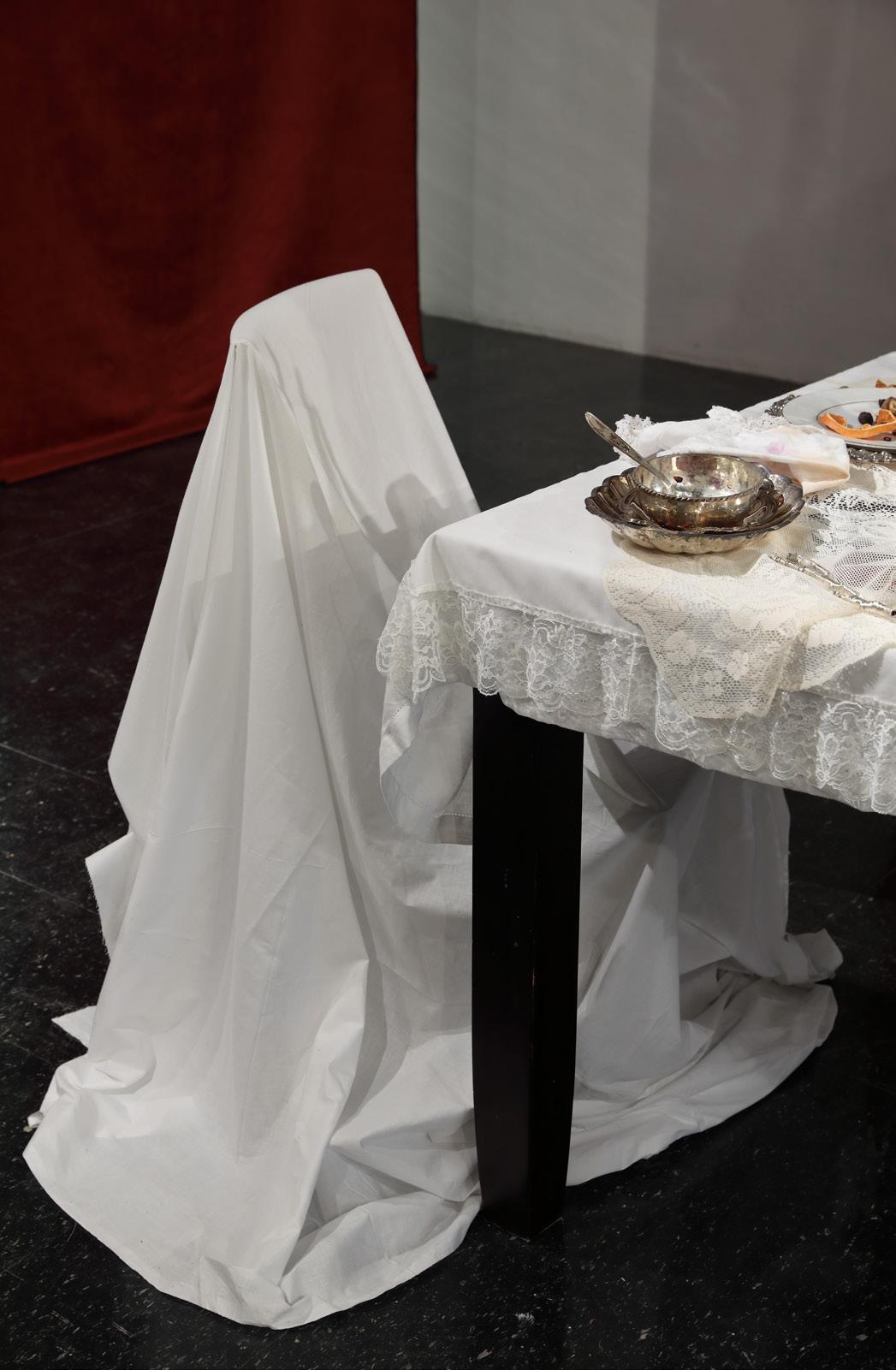





Love Letter #36 terracotta, porcelain, wax, found objects, unfired clay, plaster, foam, latex, wood, faux terracotta, rubber, concrete, tape, metal, wax, glass, plastic 11.2’ x 83.6’
I pull from a reservoir of handmade sculptural objects to create compositions that operate in a capacity akin to painting, exploring balance, connection, tension, perception, colour, and texture. These objects are iterations of their reference source, prompting contemplation through a spectrum of representation, abstraction, and proximity. This installation serves as a curated snapshot of my studio recontextualized in a gallery environment. Here, I transform ubiquitous ceramic studio objects into clay and other materials, a gradual revelation of the unexpected, confusing distinctions between reality and its representations.
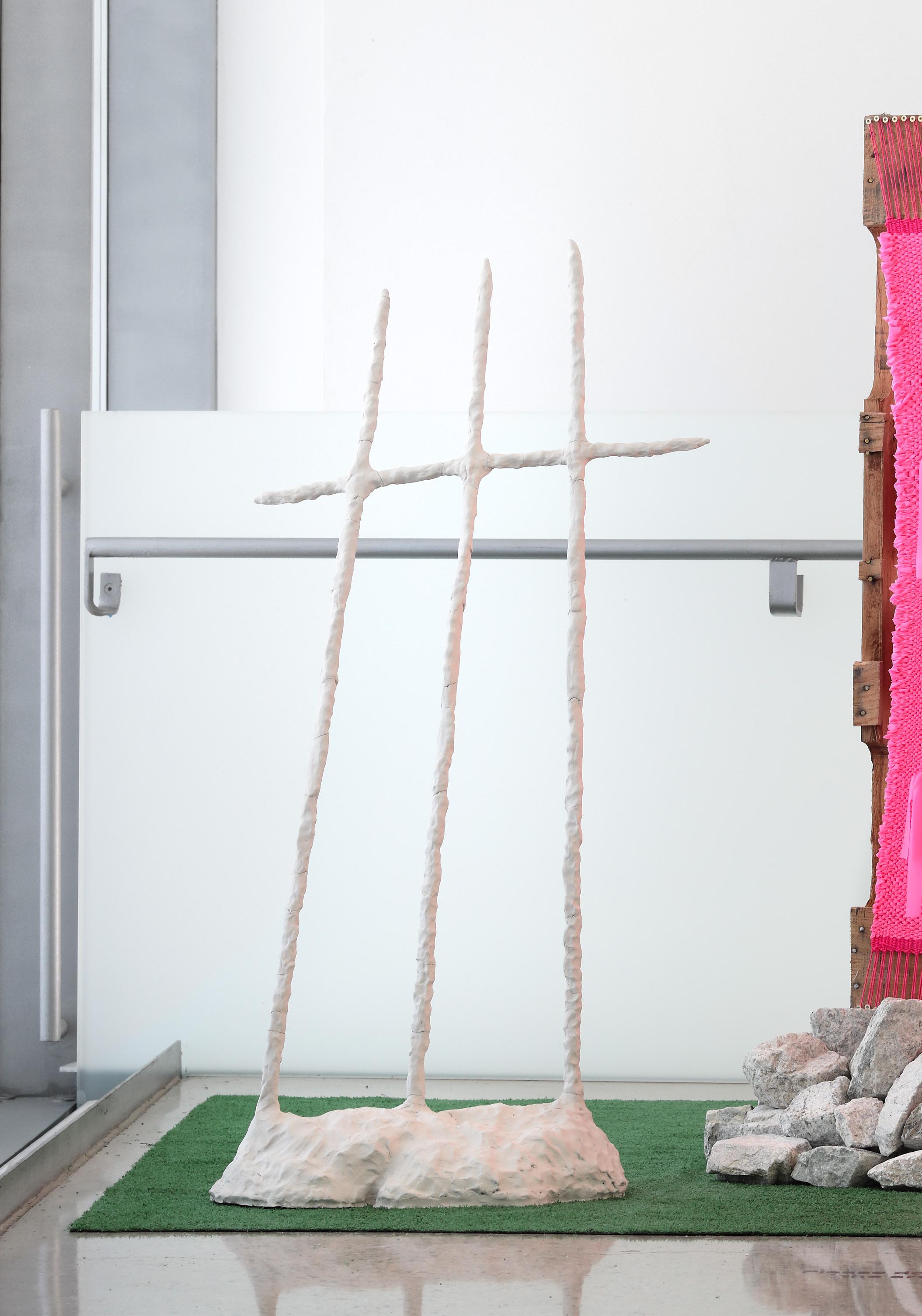
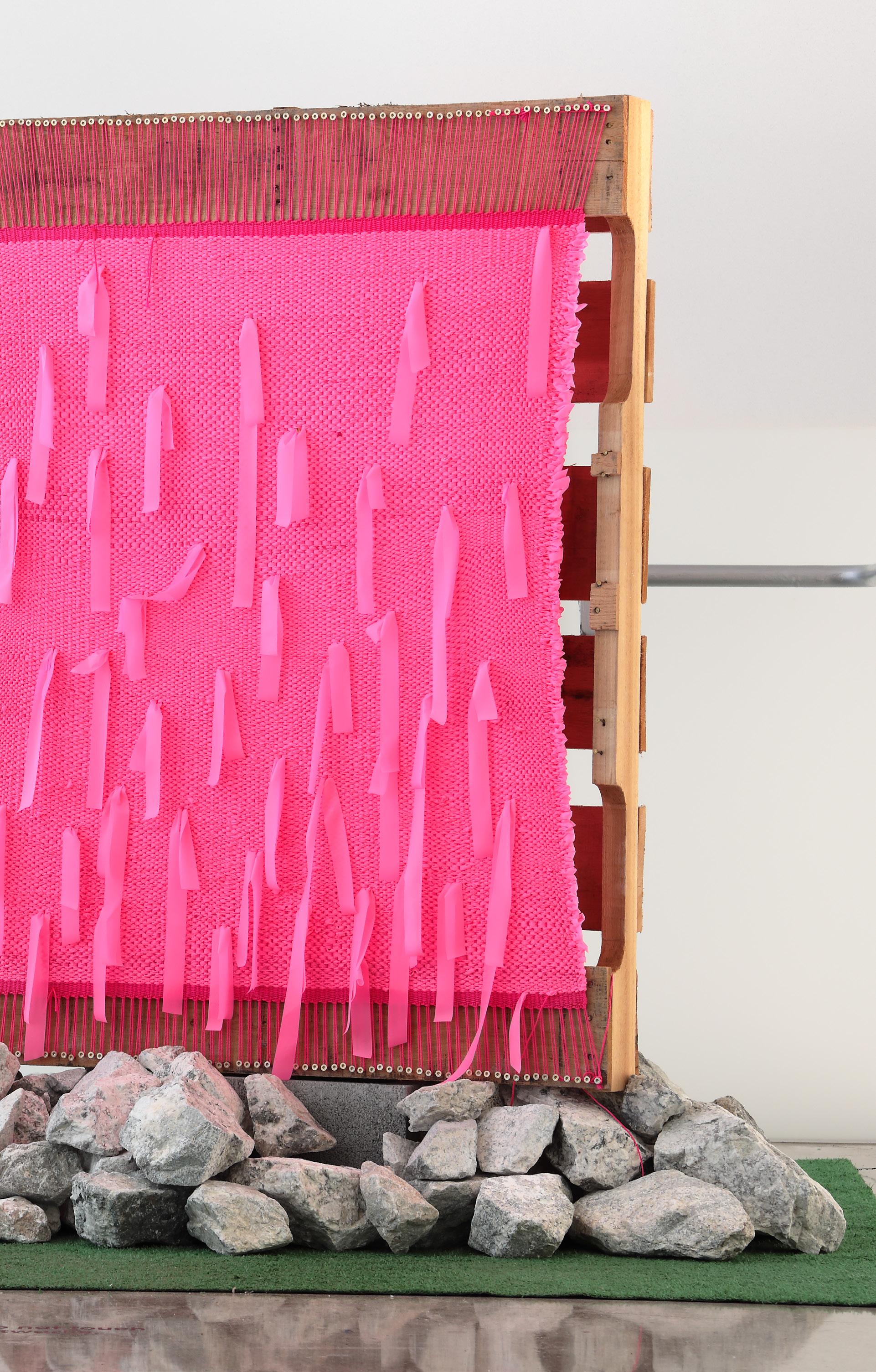

do you see me now?
Raw stoneware, terra sigillata, flag tape, mason line, found pallet, rip rap, cinder block, faux turf rug.
Dimensions variable
Installation View (p. 14-15)
Detail (above)
brooklin grantz
My work refects on gendered behaviors in domestic space, the overlap of masculine and feminine labor, and otherness. I utilize materials and processes akin to the activities I have witnessed of the men and women in my life, relating to their labor through making and altering. Clay, textile, wood, and plastic form abstract assemblages familiar to my childhood home and yard.
the view from over here (opposite) Stoneware, stain, flag tape, mason line, found pallet, paint, landscaping fabric.
Dimensions variable

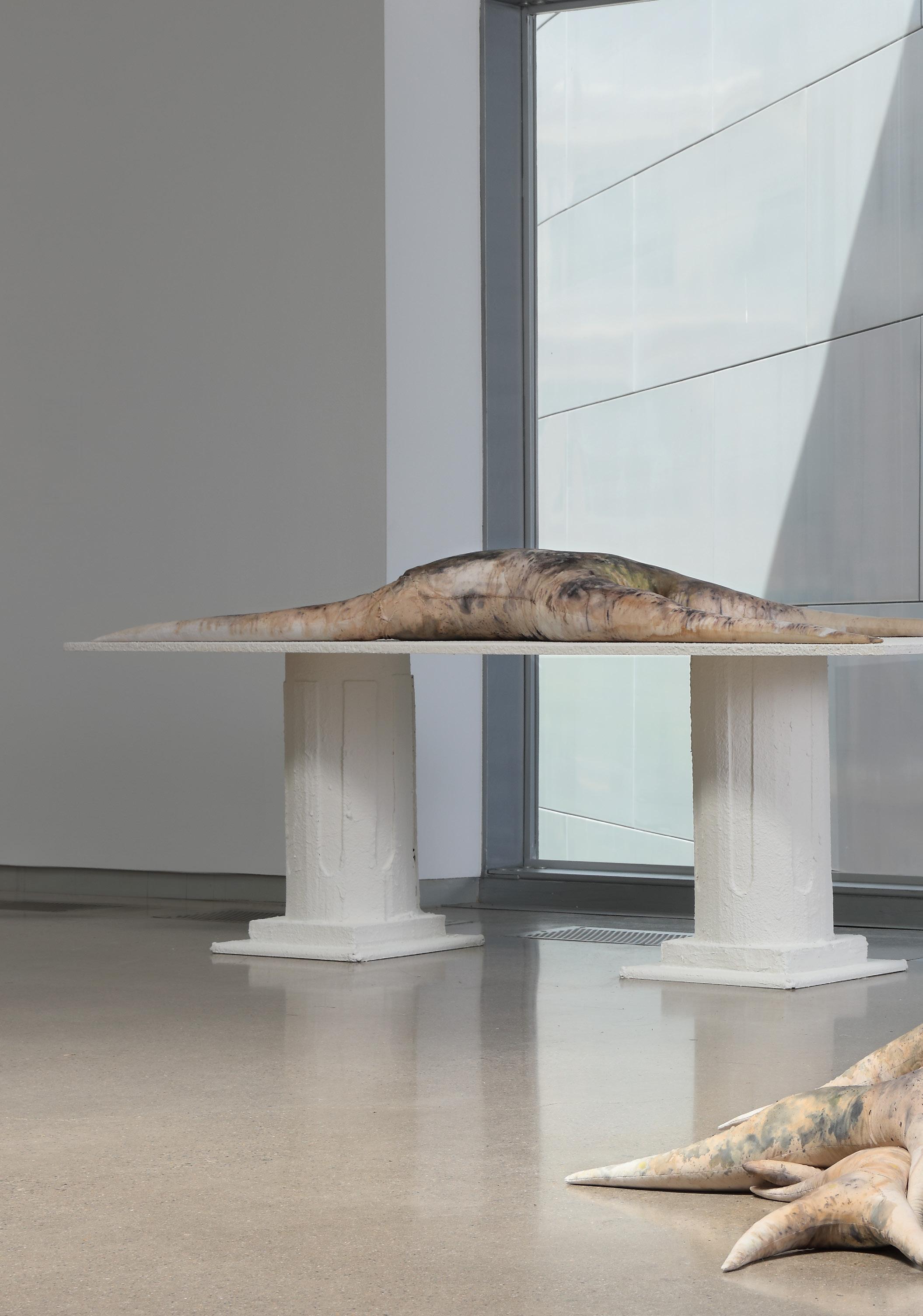

Aleckxi Hristou-Dorhofer
I have been refecting on my past decade-long struggle with anorexia and bulimia. Reinterpreting this experience through the lenses of mythology and magic, I have constructed these Stygian carcasses (from the river Styx, which serves to separate the living and the dead) using my own bodily proportions in muslin, an intermediary material which requires transformation. In this work, I utilize these forms to symbolically rot for me as my body did, performing a type of sympathetic magic (magic worked from afar on another person) on myself, extending my life and allowing all which occurs between birth and death to afect these forms and not myself.

Installation View (p. 18-19)
Self Portrait (in Abjection) (right)
Cloth, Dust, Thread, Water from the Five Rivers of the Underworld (Woe/Salt Water, Lamentation/Iron, Boundary/Sweat, Fire/Bile, Memory)
92” L, 32” W, 13” D
Self Portrait (Fragments, Attempts) (opposite)
Cloth, Dust, Thread, Water from the Five Rivers of the Underworld (Woe/Salt Water, Lamentation/Iron, Boundary/Sweat, Fire/Bile, Memory)
Dimensions Variable
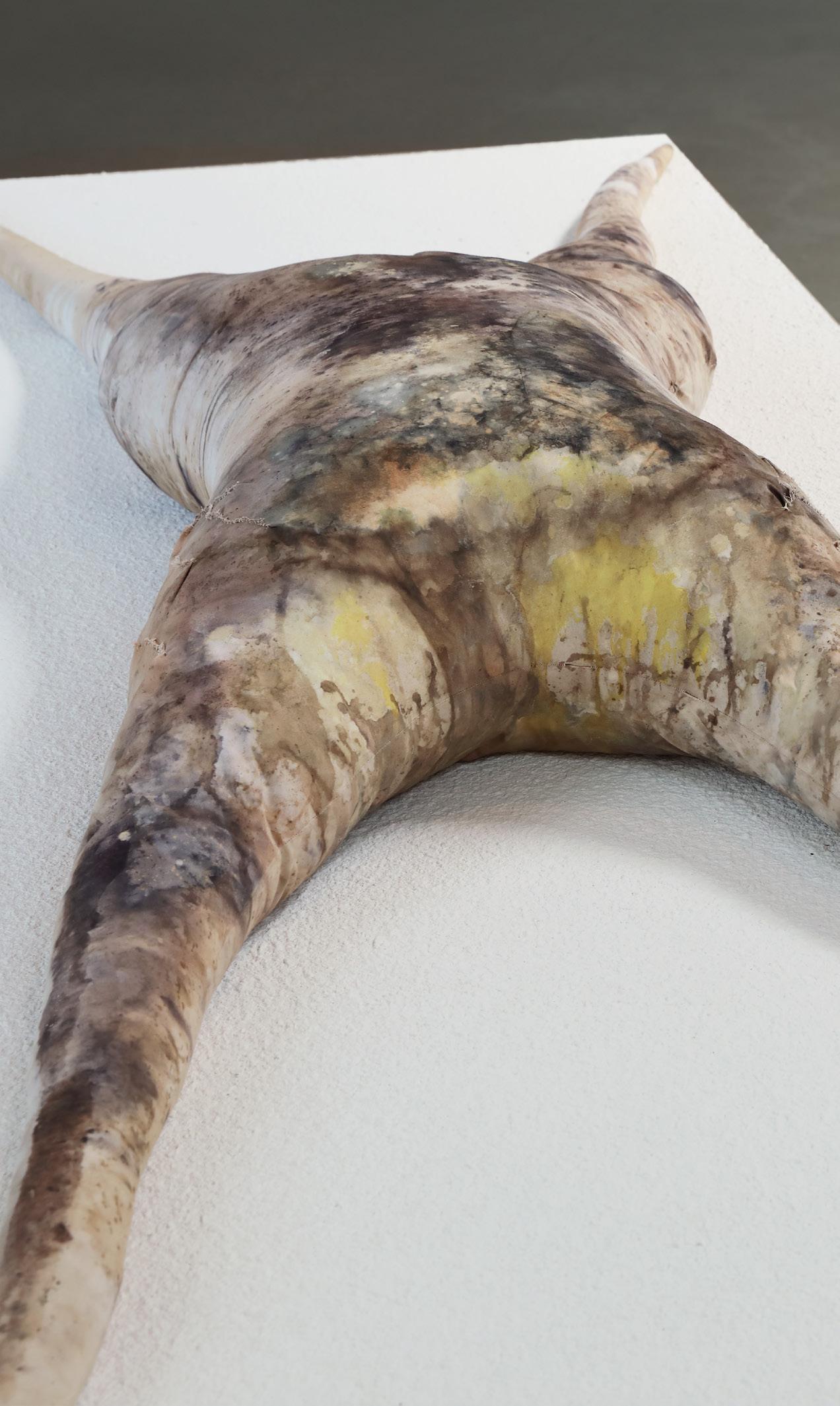
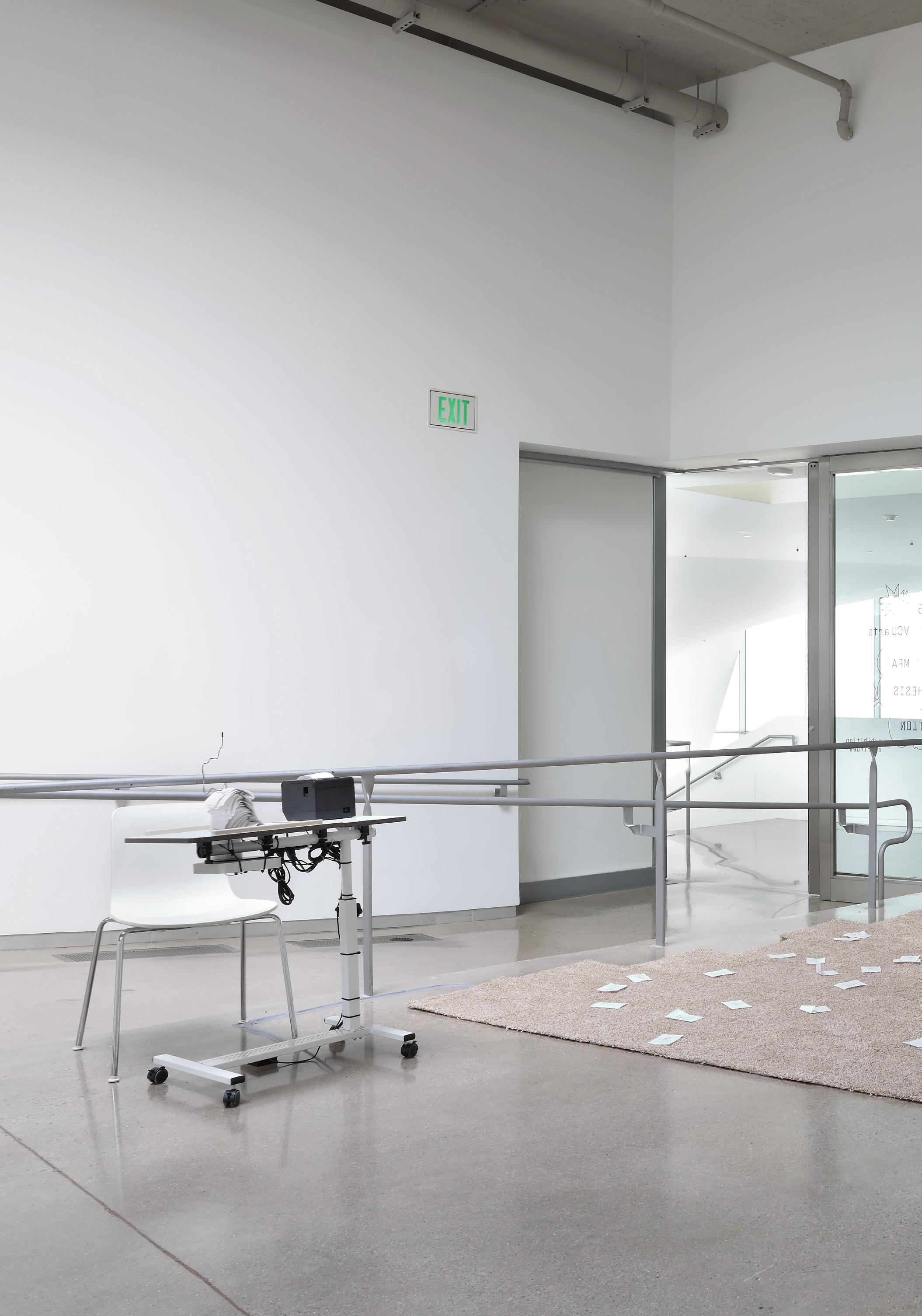
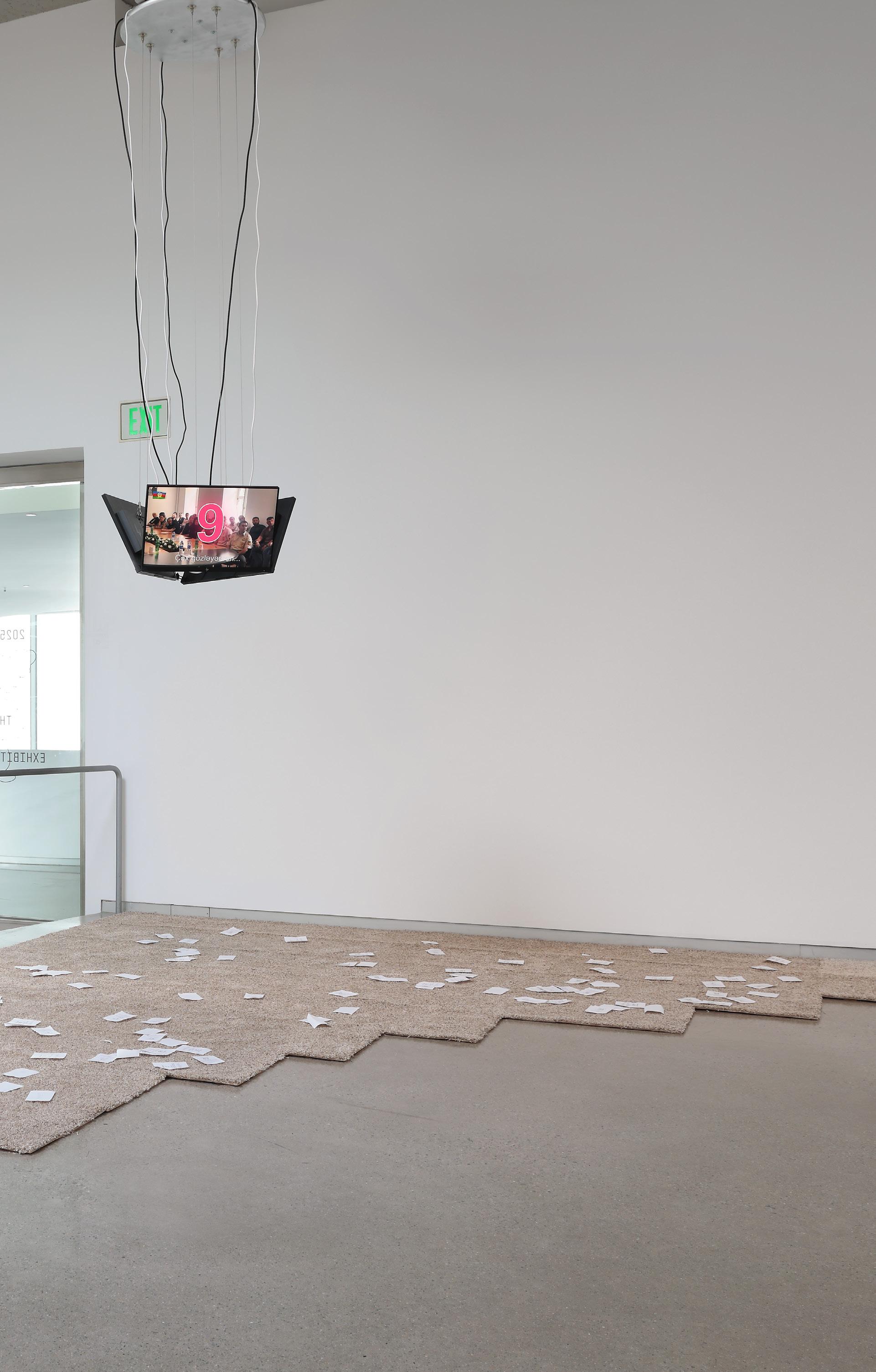

How long does it take to get a hug Website, 27-inch monitors, carpeted floors, table, thermal printer, receipts spike, chair, Mac mini, me 12’ x 10’ x 12’
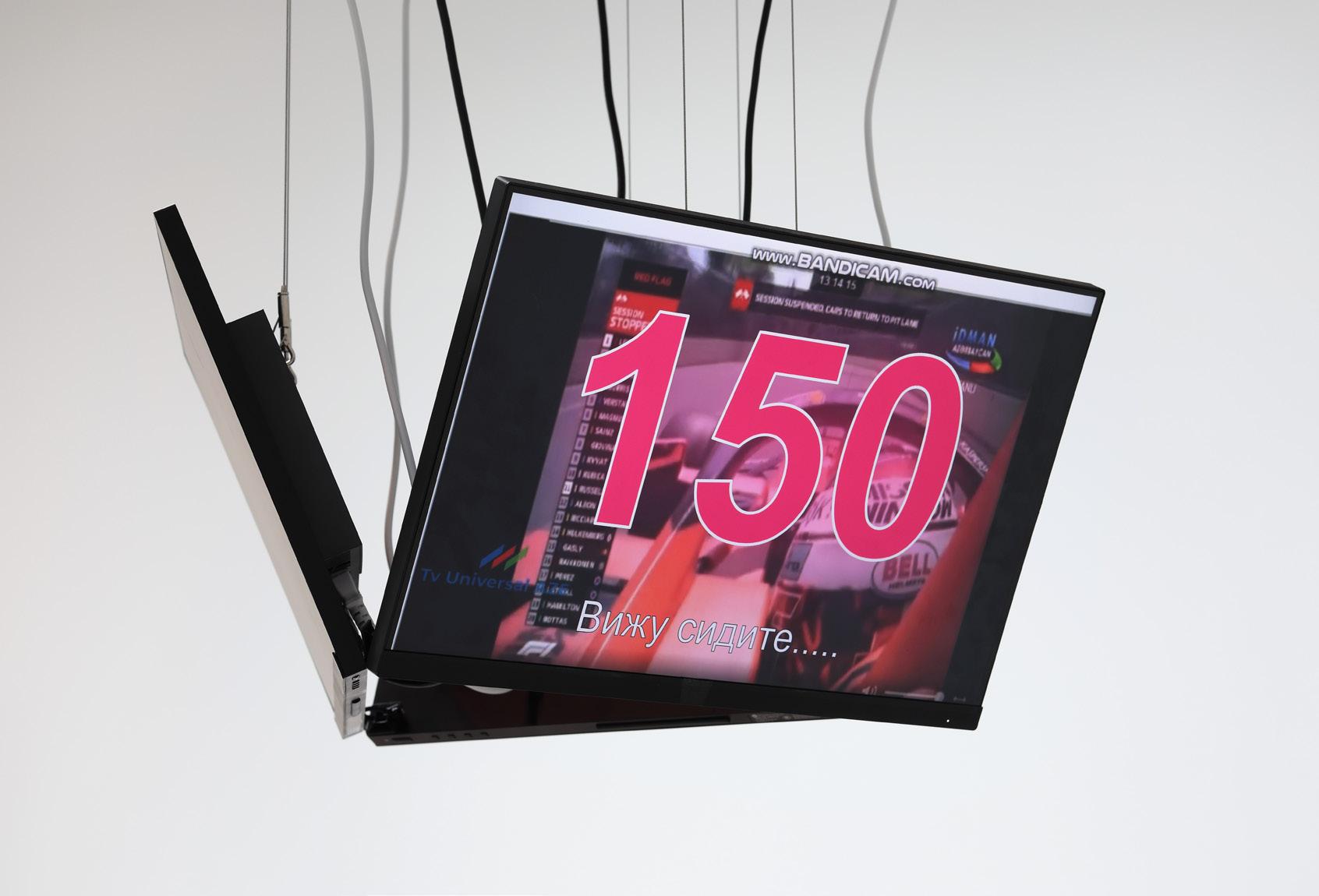
Rasim Bayramov
Exploring the post-post soviet, How long does it take to get a hug navigates the infrastructural and emotional residue space through bureaucratic and non-bureaucratic ephemera with the goal of asking the question: Can bureaucracy make two people hold hands?
To expand on how bureaucratic spaces see humans and vice versa, the project creates a bufer zone of waiting in a museum space. The exhibition creates two diferent zones of interference, where (1) at the entrance guests are greeted through a checkpoint to receive their receipts and (2) where at the exhibition space the guests are invited to participate in a waiting limbo. Drawing clues from post-post soviet technologies, bureaucratic (mis)uses of those technologies and national production followed by these (mis)uses, the exhibit imitates a proportionally blown out version of an aimless waiting room.


Ghosted (reply STOP to stop)
10 cell phones, charging cables, and 4,770 SMS texts
Time-based piece occurring over 28 days; Dimensions variable
Molly Garrett
Mass political texts can’t be sent by automation; for every message you receive, someone personally hits send. Any responses to these political texts are recorded—but not usually read.
In 2024, a campaign sent text messages to third-party registered voters about a Libertarian presidential candidate, Chase Oliver. This project contains the responses that campaign received—examining the language in politics and the power dynamics of being heard.
In election seasons, we fnd ourselves trapped in an unending one-way conversation. When given the opportunity to respond, sometimes we take it. We yell into the void. Ghosted is an archive of that void.

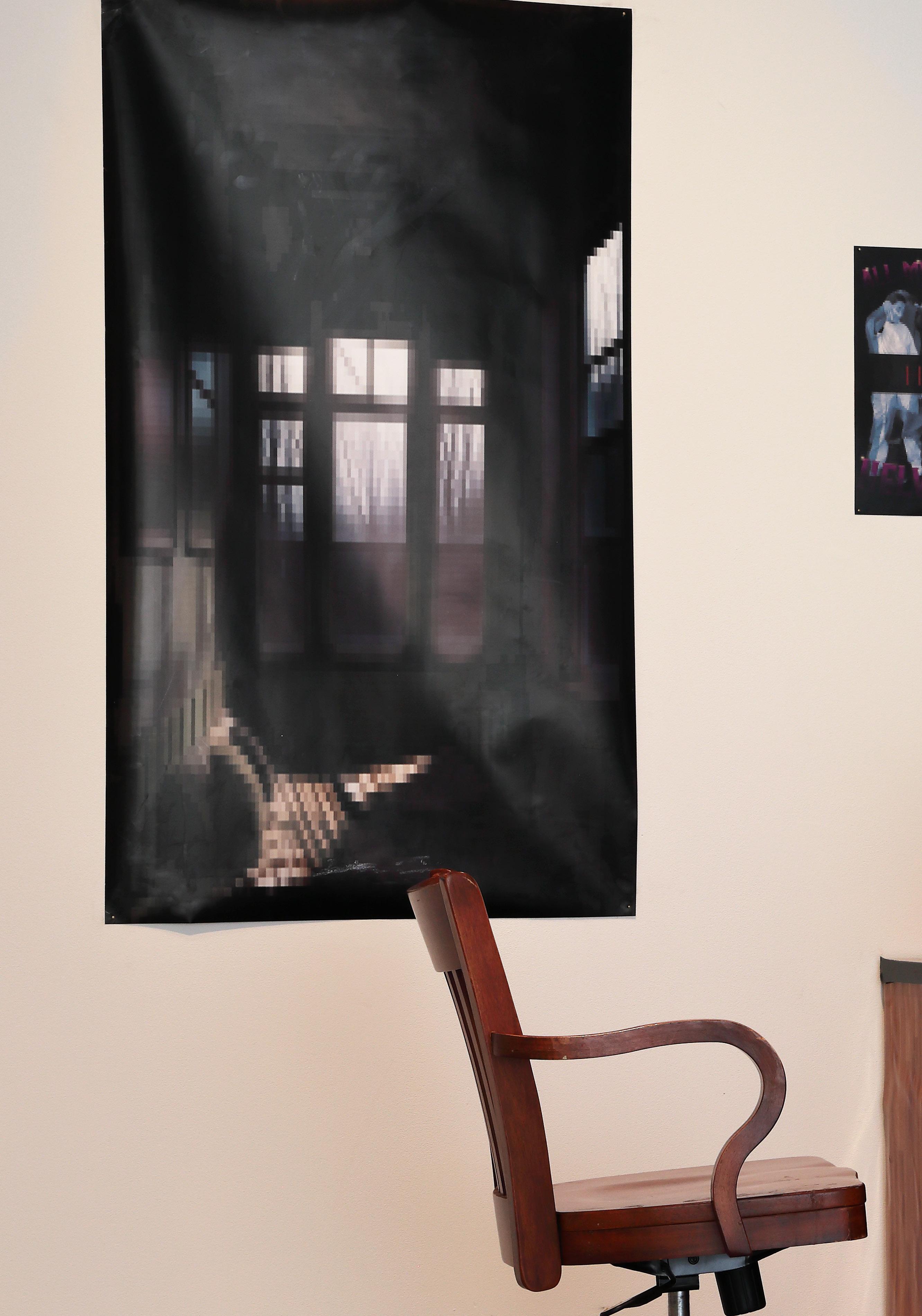


In These Worlds
Interactive video, desk, chair, ephemera, metal wiring, wood
Dimensions variable
Tariye George-Phillips
The internet is a medium that has drastically evolved since its conception. Since I was able to understand web surfng, I have been a child of the internet, existing in many metaverses, embodying many avatars. This exploration largely shaped both my analog and digital experiences, as well as how I perceive the links between the two. My work examines the use of avatars as a medium of self expression, the collective nostalgia of the “computer room” creating a designated destination for web browsing, and how the transformation of social media altered the way that we use the internet. Using an interactive environment to control a digital avatar, I attempt to examine the bridge between analog and digital existences.



Aya Khalife
My thesis project interrogates how western media often obscures the realities of middle eastern conficts. Threads of memory centers around a series of double-sided posters that critique the ways media simplifes complex narratives, specifcally human tragedies in the middle east, into numbers and generic headlines. Inspired by the powerful voices of arab writers, this project seeks to reclaim the depth of these narratives, contrasting lived experiences with the often reductive language of western media.
Along with threads of memory, my thesis project will include an interactive website. Upon visiting the website, users are prompted to answer a selection of questions with numbers.
After answering the questions, the website generates a selection of New York Times snippets about Lebanon. Each new user session presents a diferent combination of snippets, with the user’s answered numbers flling in gaps that correspond to casualties, displacement, or other confict-related statistics—revealing the detached language often used to report on traumatic events. As a fnal step, users are invited to print their results.
The results, printed as double-sided, lightreadable pages, become tangible artifacts of dehumanization. Together, the projects critique the reductive portrayal of middle eastern conficts, emphasizing the repetition of war and resistance across time.





Yvonne LeBien
There are two rooms in the space. The frst room is where the audience enters. There is a line on the foor marking that the audience is not to move further into the frst room or into the second room. The maximum capacity is ten people.
The audio consists of verbatim comments sourced from videos of violence against trans people from the website watchpeopledie.tv, a website in which users post real videos of shootings, suicides, car accidents, etc. The booklet is an interpretation of these comments. The performance consists of me sitting naked on a stool, restricting all movement in order to remain completely still, yet trying to get up and leave the frame at the same time. When I do move my presence is disturbed by the walls separating the two rooms, the lines created by virtual space/time.
The performance lasts 3 hours.
watchpeopledie.tv
Durational performance, four channel audio, booklet



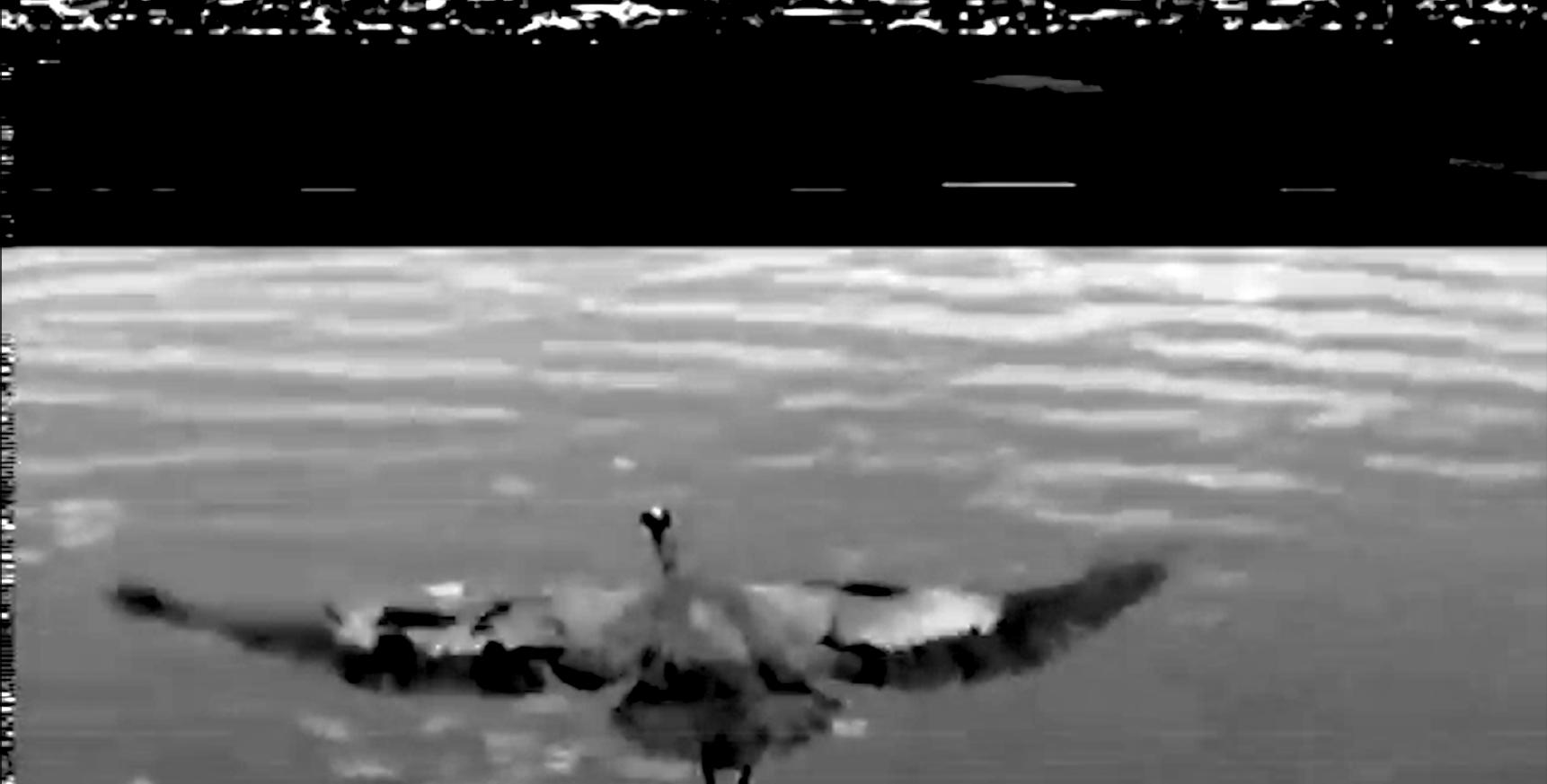



Quinn Standley
Orb Weaver is a flmic passageway into the haunted and mysterious world of a psychotic mind, as revealed through pages of a journal discovered in a pile of trash. Written inside include detailed scientifc diagrams, telepathic messages from higher powers, and ethereal accounts of alien abductions.
Through surreal, dreamlike visuals, the flm questions the nature of reality, studying how an individual’s consciousness shapes their perception and experience of the world.

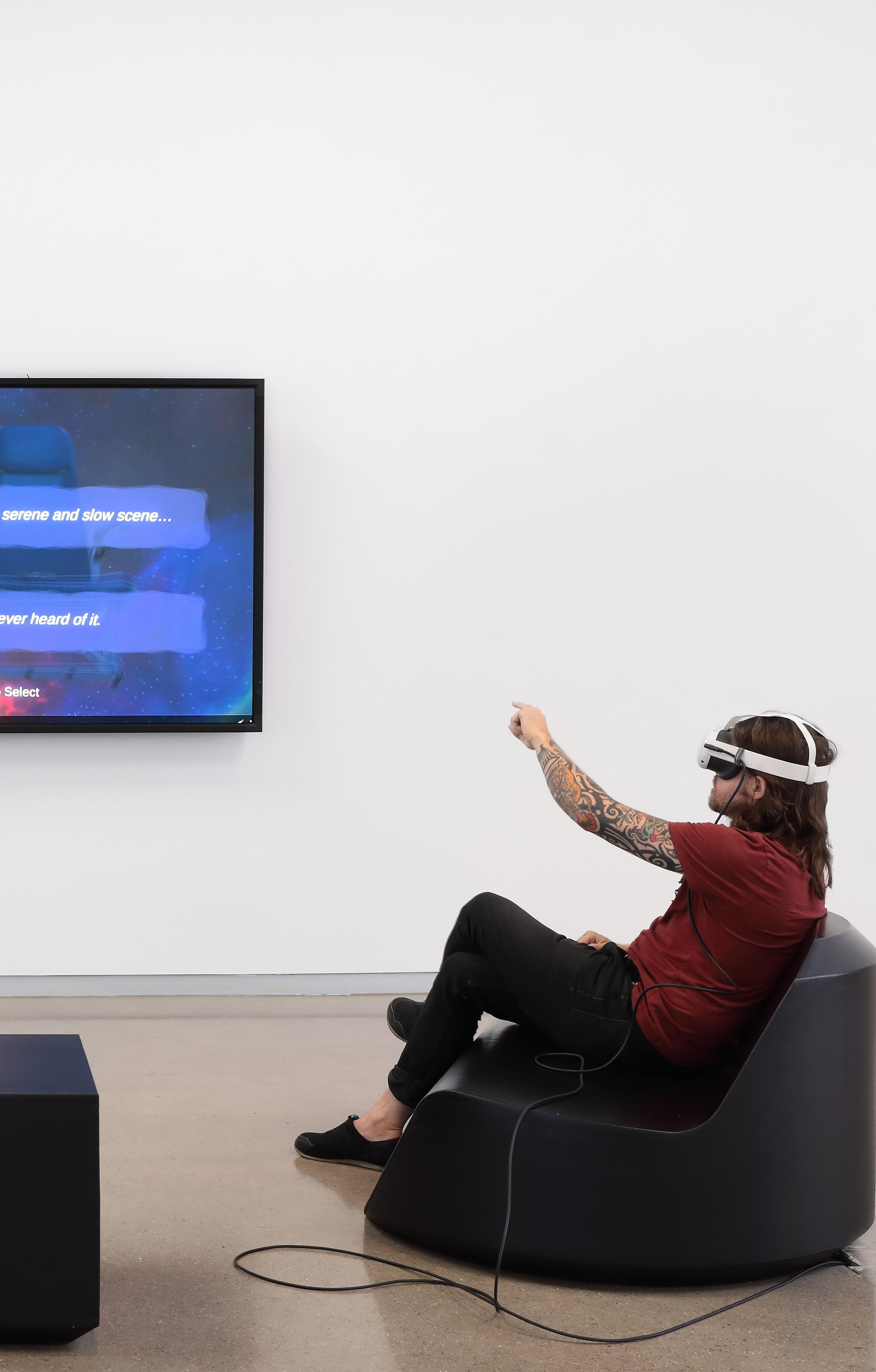
Weitong Sun
Ideal Home is an extended-reality (XR) narrative project exploring how immigrant experiences and the concept of home are reshaped through emerging technologies. Immigrant writers were invited to co-create a text archive of memory and displacement. A fne-tuned GPT-4 model rewrote it into a unifed script, transforming cultural symbols into something unexpected. By embedding the script into a game engine, the project blurs oral history and generative fction, ofering an alternative mode of engagement. A ghostly AI avatar drifts through layered interfaces, landscapes, and symbols, guiding players through fickering memories and cultural echoes—co-authoring a new language of belonging with machine intelligence.
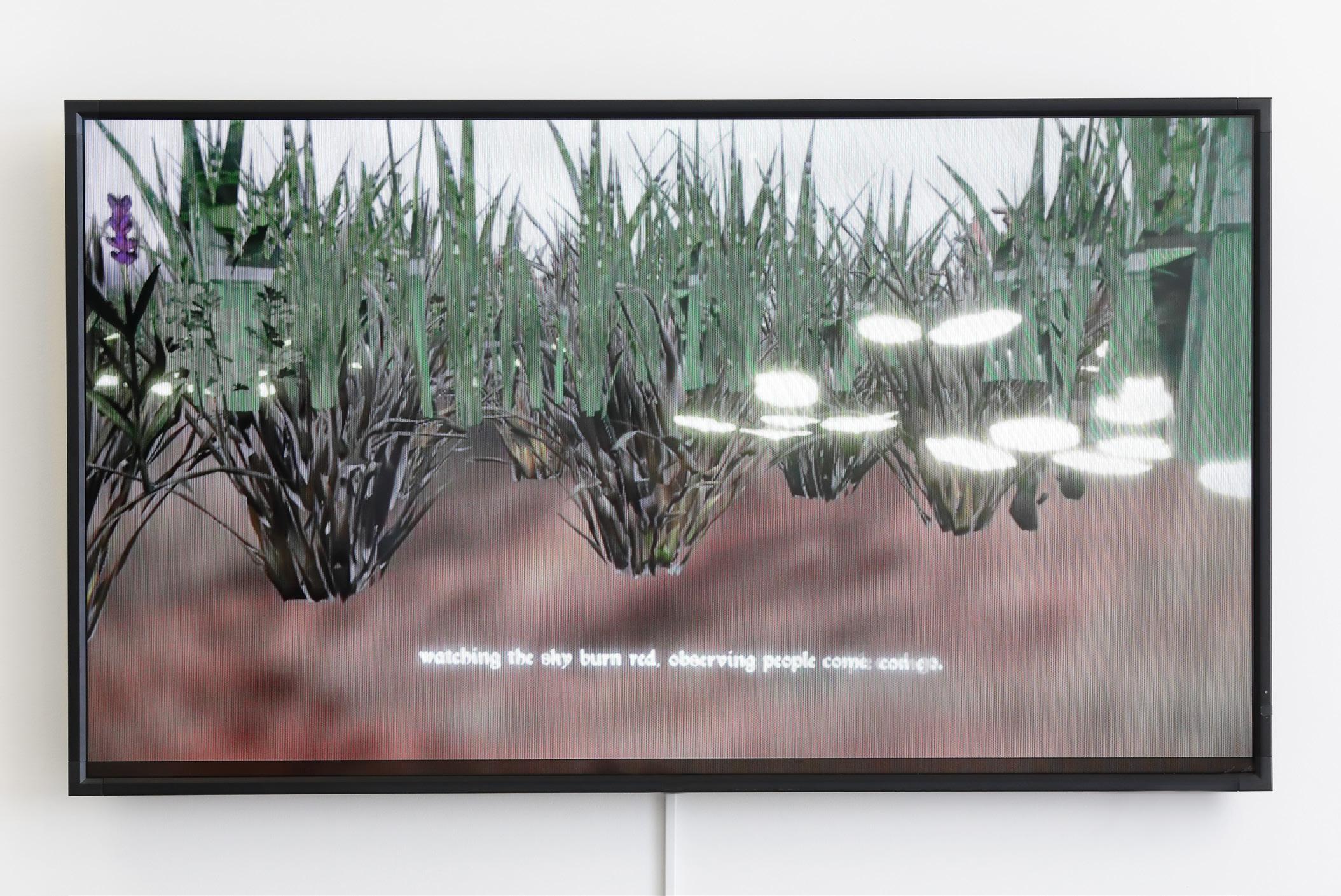
Ideal Home
Extended Reality (XR), Quest 3 Headset, TV monitor (Quest Casting Display)
Art Directors: Weitong Sun, Ruiqi Zhang
Sound Artists: Jared Duesterhaus
Quest XR Technical Support: Gu Lin, Jiaqi Yang, Yufan Yao
Script Co-Writers: Rasim Bayramov, HWIY, Xinyue, Weitong Sun, Ruiqi Zhang, etc.
Editor:
Artists-trained AI Editor (GPT-4), Yvonne LeBien
Special Thanks: Dongxue Dai, Mingyue Liu


Wren Tifany


Wren Tifany
The Green Room is an open studio residency that examines the transformative processes of video editing, performance, and gender transition through my queer relationship to the webcam, green screens, and the art of drag.
‘Chroma-keying’ is a tool of erasure, a process currently unfolding on the history and identities of trans people in America today. Come with ‘Lady Boner’ into the neongreen slime ooze of the unknown—where transformation, ecstasy, and salvation await.



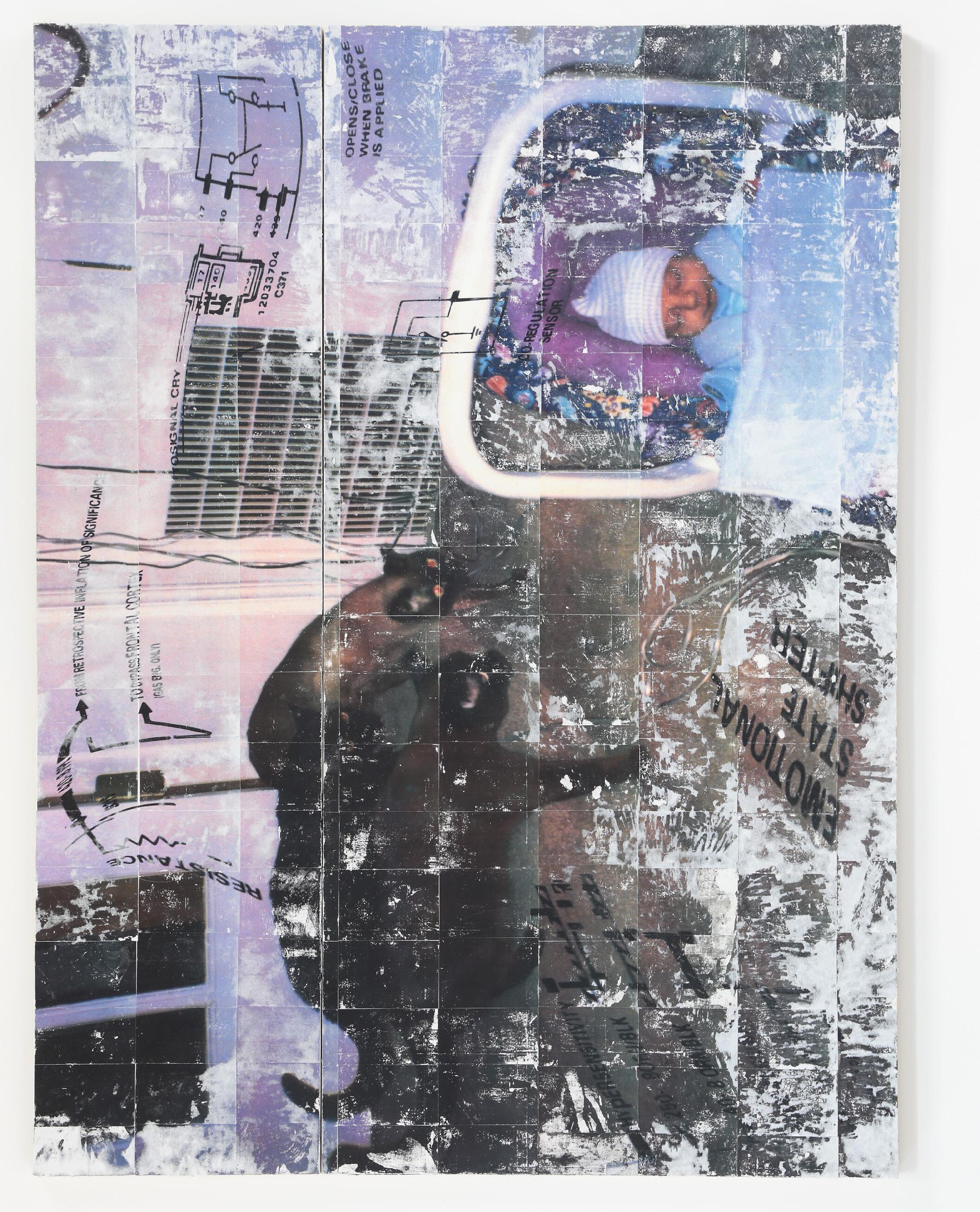

Alex K Bacon
The works in my thesis exhibition layer the formal and syntactic structures of GMC wiring schematics, the language of attachment theory, and photographs from my infancy, to examine the role my babysitter’s 1995 GMC Suburban played in forming my attachment style. Each image projects a psychological stratification of sorts, and when the modified attachment diagrams come into contact with images from my personal archive, it becomes possible to compare the maintenance of a GMC Suburban with the infancy of a suburban baby boy.
Timeout (opposite)
Oil, acrylic,
(Diagram 23) (above)
oil, acrylic, and mixed media on canvas over wood

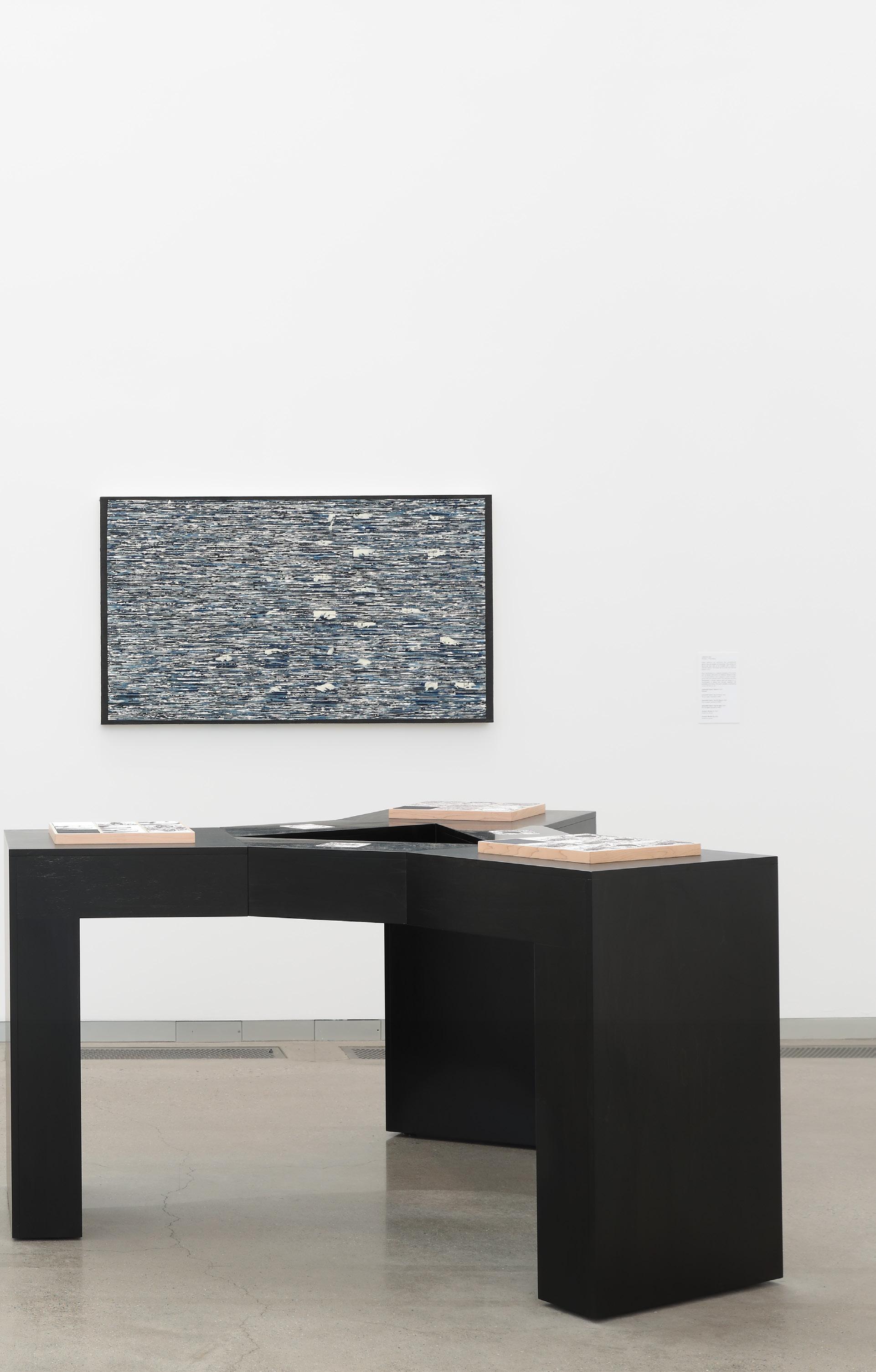
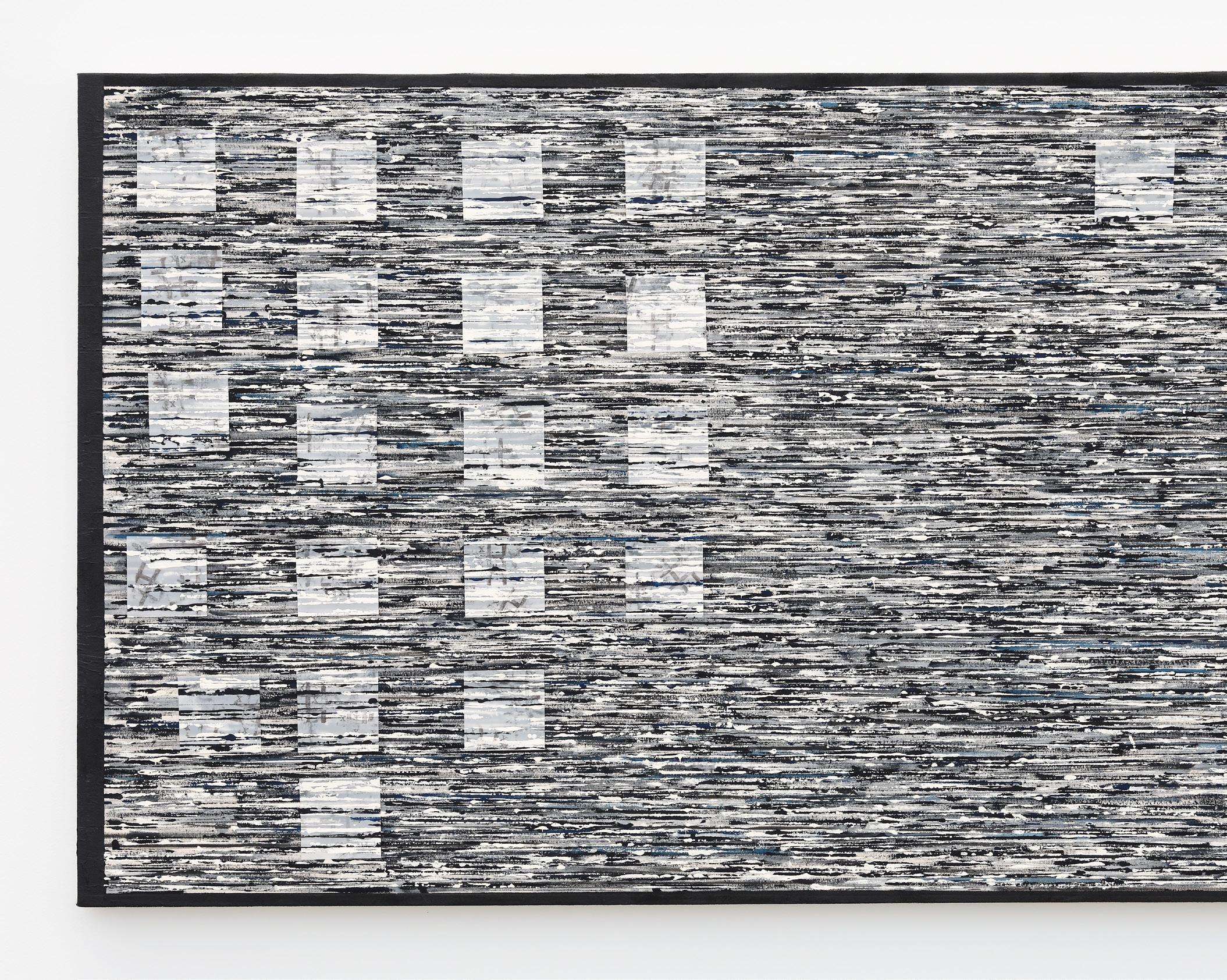
Catherine Chen
Digital platforms are surreptitious structures that gamify the ways in which we engage and exchange. They dictate every step of our journeys even as we navigate onward with a sense of absolute agency. The harder that we try to win, the more the platform will win!
Brute Gamifcation is a material unraveling of the terms and conditions with which url
platforms dictate irl lives. A literal platform supports a series of image-games, all of which have already ended. The triangular structure premediates a circular viewer path that allows for an accumulation of seeing, and, through repetition, the possibility of knowing. If the game still persists, then all remaining moves will lead to tie. . .




Installation view (p. 62–63)
Note to self (right)
Cardboard, paper towel, wallpaper glue, acrylic paint, graphite, colored pencil, pastel, graphite on paper
9”x11”x10”
Rock prize (below)
Cardboard, paper towel, wallpaper glue, acrylic paint, graphite, colored pencil, pastel, inkjet print on duralar, wire, cabinet light
13”x12”x10”
Ladder (opposite)
Colored pencil on duralar 24”x110”


Madeleine Herisson-Leplae
Our earliest forms of written language were symbols carved into stone, rearranged to create and transform meaning. This body of work, sparked by my love for memes, refects my ongoing determination to communicate through images. I’m drawn to the fuidity of meaning, the way nothing can ever be fully captured or fxed, but instead remains open to constant reinterpretation and reinvention through reorganization. I explore how images hold and lose meaning depending on where, how, and by whom they’re discovered. I’m particularly interested in the surprise of fnding something unexpected, and how that moment of discovery rewrites the meaning of what came before.



Diego Pablo Málaga
Using the American car as a jumping of point, my work investigates its role in society as a symbol of class and luxury. Cars are synonymous with America, they consume vast resources–often obtained through imperialistic practices–while also being one of the leading causes of death.
But the car central to my work cannot be farther from the sleek and glossy cars advertised to us ad-nauseam. My compact Honda Civic, Guadalupe, is far from perfect: her A/C is broken, her seats are stained, and she needs repairs. Yet, I’ve become my adult self in her interior. I’ve decorated Guadalupe with countless bumper stickers, and hung pink fuzzy dice from her rear view mirror. In my work, Guadalupe embodies the way marginalized communities engage with hegemonic symbols. I paint Guadalupe over and over again, in an attempt to demonstrate how minority cultures can reclaim and redefne oppressive symbols by transforming them into sites of personal expression.
Installation view (p. 66–67)
Guadalupe Interior (opposite, top)
Ruta de Vuelta (Collage 1) (Detail; opposite, bottom) Oil, acrylic, silkscreen prints on canvas, paper and panel board, 13 works 5’ x 4’
Ruta de Regreso (Collage 2) (below) Oil, acrylic, graphite, charcoal, silkscreen, and digital prints, on canvas, paper, and panel b-oard, 12 works 6’ x 4’


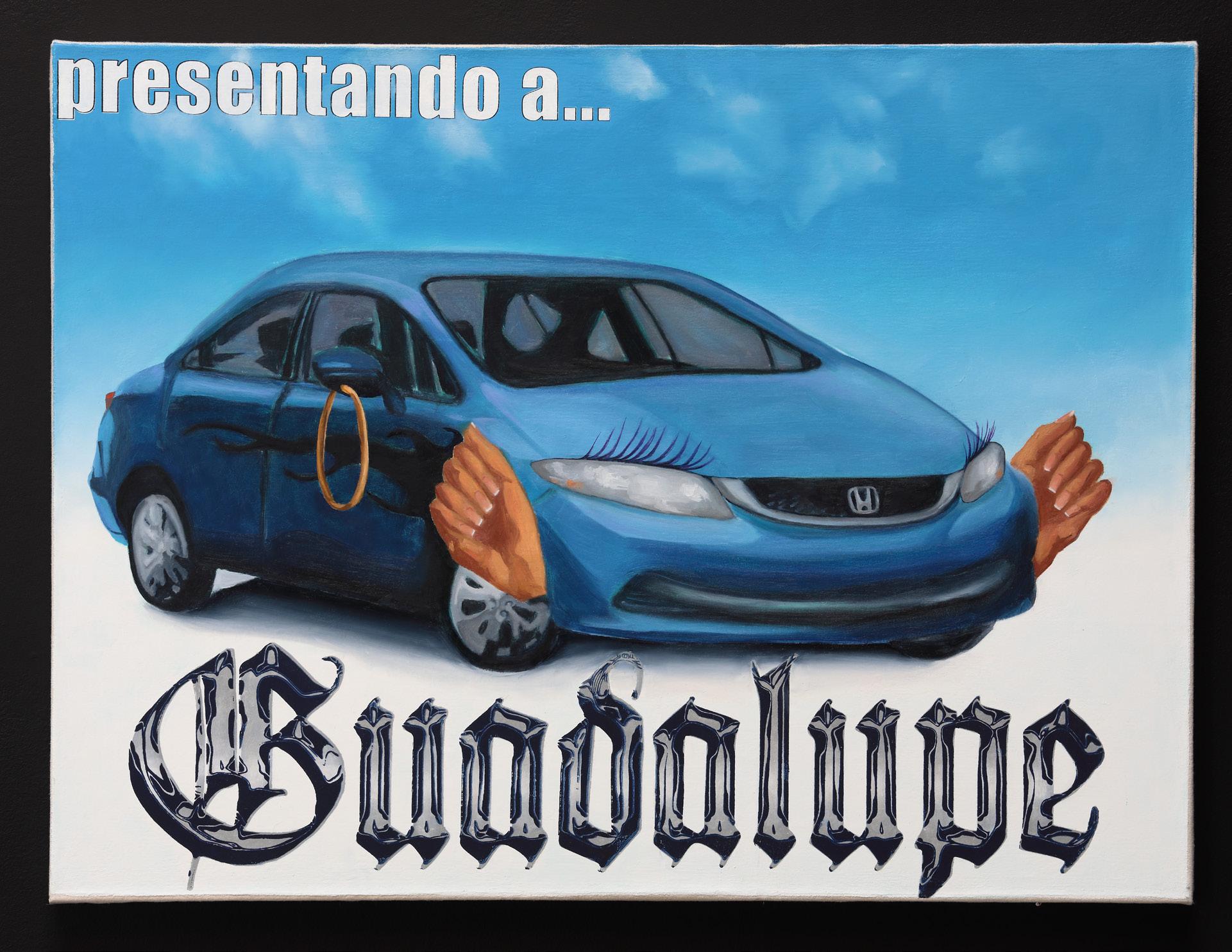
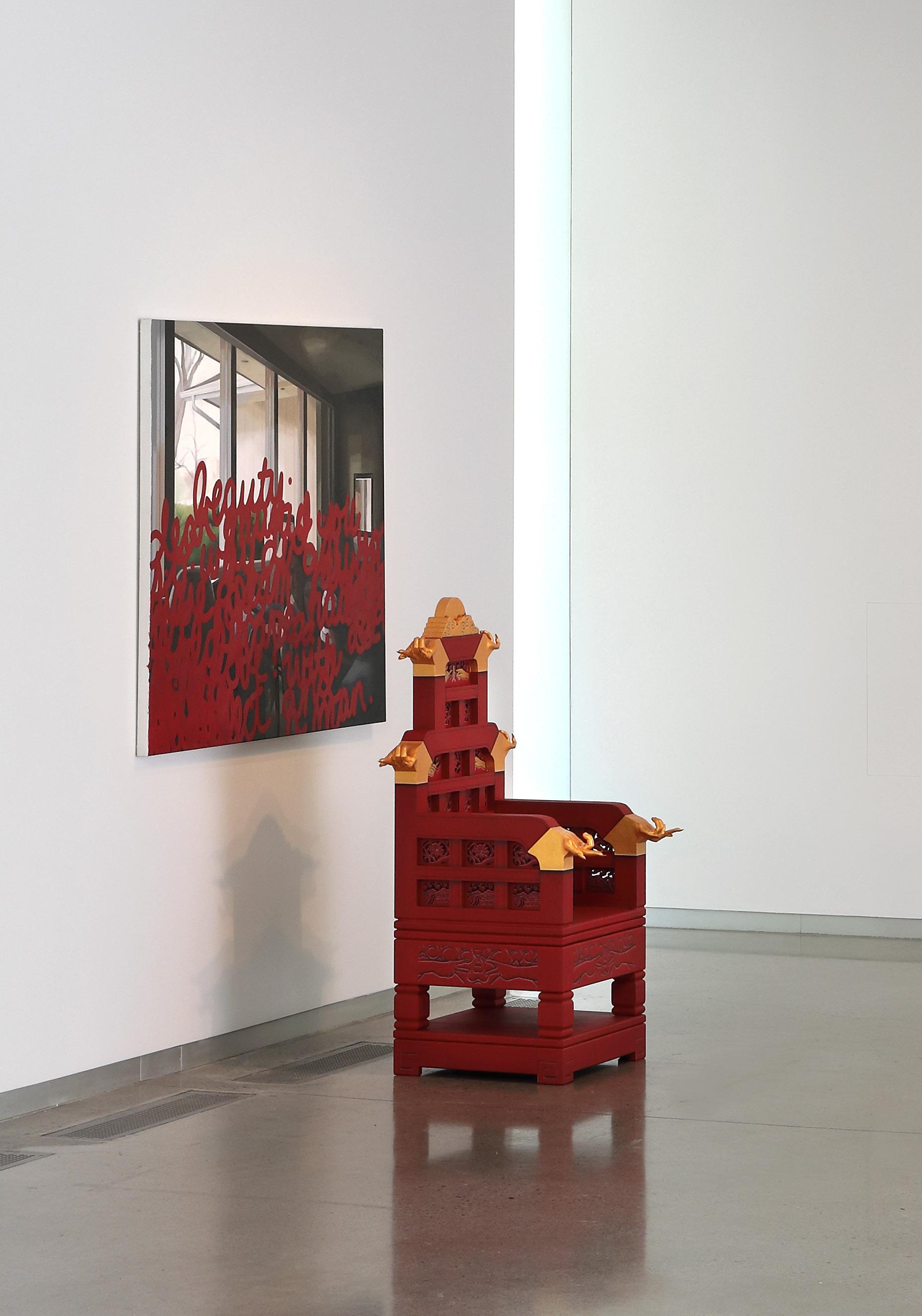


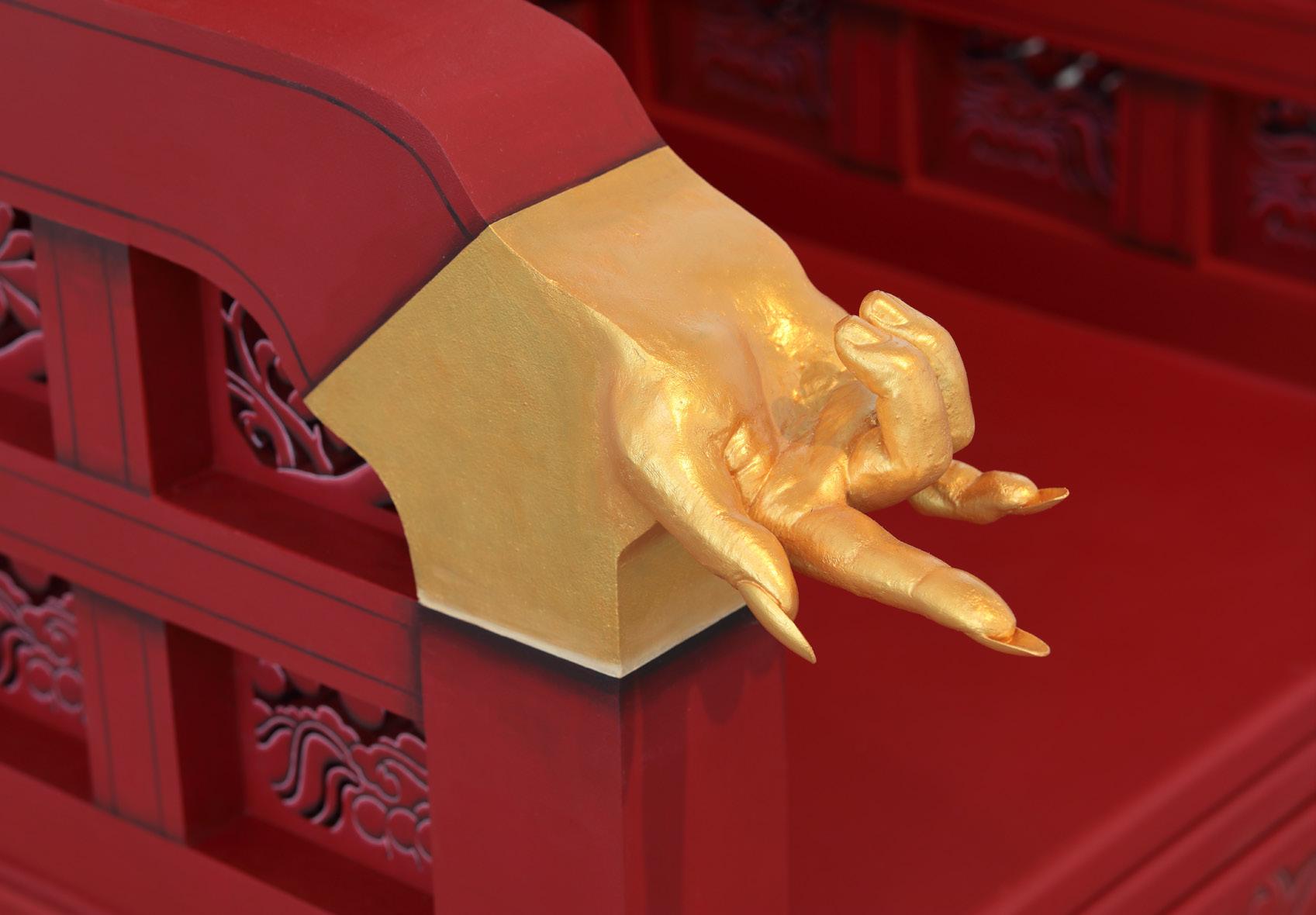
Rebecca Oh
Things are always lost in translation, whether between the speaker and listener or between the past and present. Intention and interpretation is another example of loss. How can a concept be wholly understood by someone if the presenter is simultaneously learning the language? My pieces aim to tell the story of my life in the context of an ancestral history that would have erased facets of my existence.
Using painting, woodworking, and interactive sculptural forms, I examine objects loaded with historical weight—thrones, bodily artifacts, domestic forms—and reconstruct them to refect a fractured but persistent sense of self.
Installation view (p. 70–71)
Dear Manic Pixie Dream Girl (Opposite, top)
Oil paint on canvas 48 x 60 in
The Red Chair (Detail; opposite, bottom)
Acrylic paint, poplar wood, two-part epoxy, wood filler, ABS 3D printing filament, liquid gold leaf 52 x 35 x 27 in
It’ll Be Over Before You Know It (Right)
Capsule machine, basswood, acrylic paint, liquid gold leaf 18 x 50 x 18 in
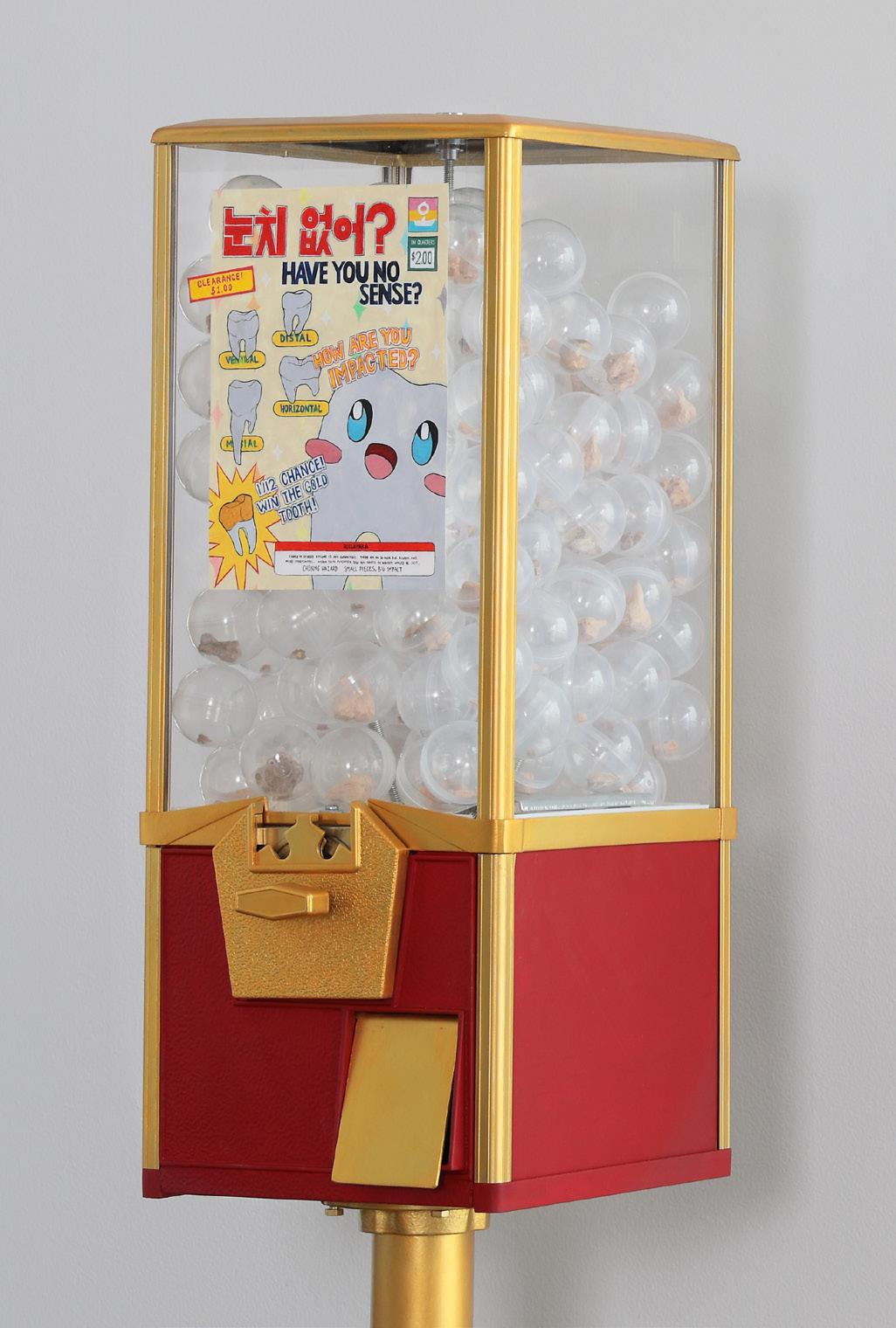

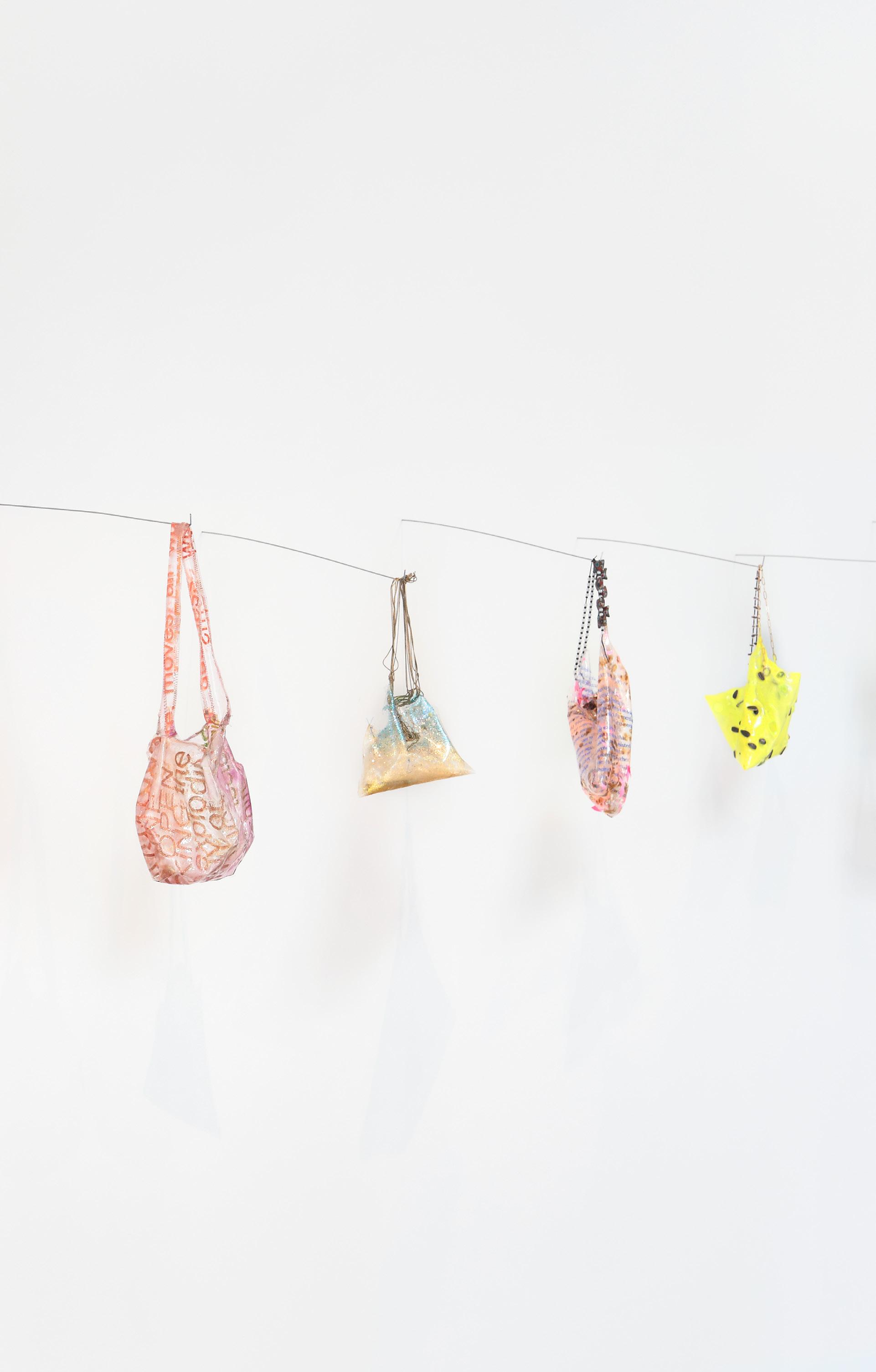
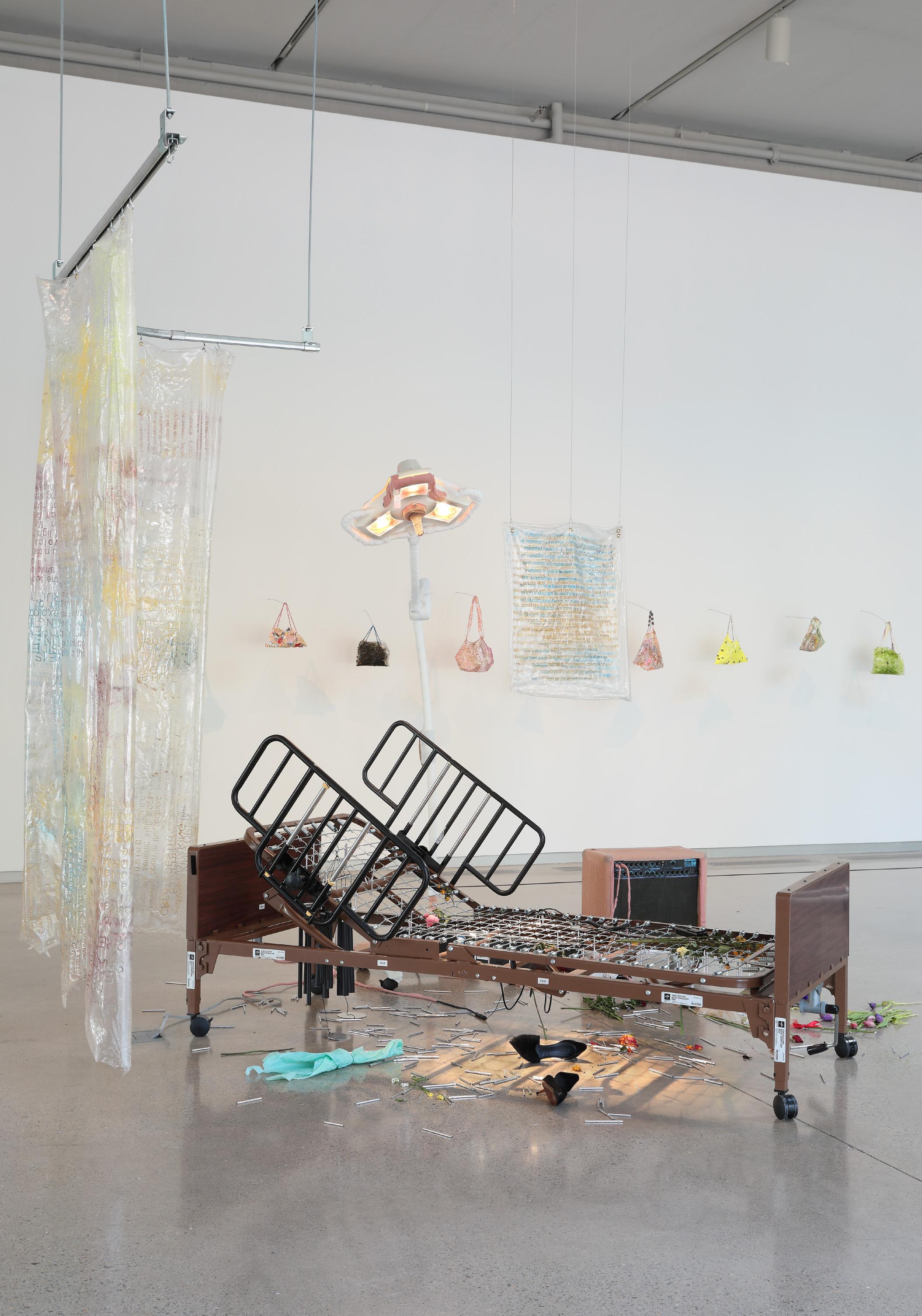
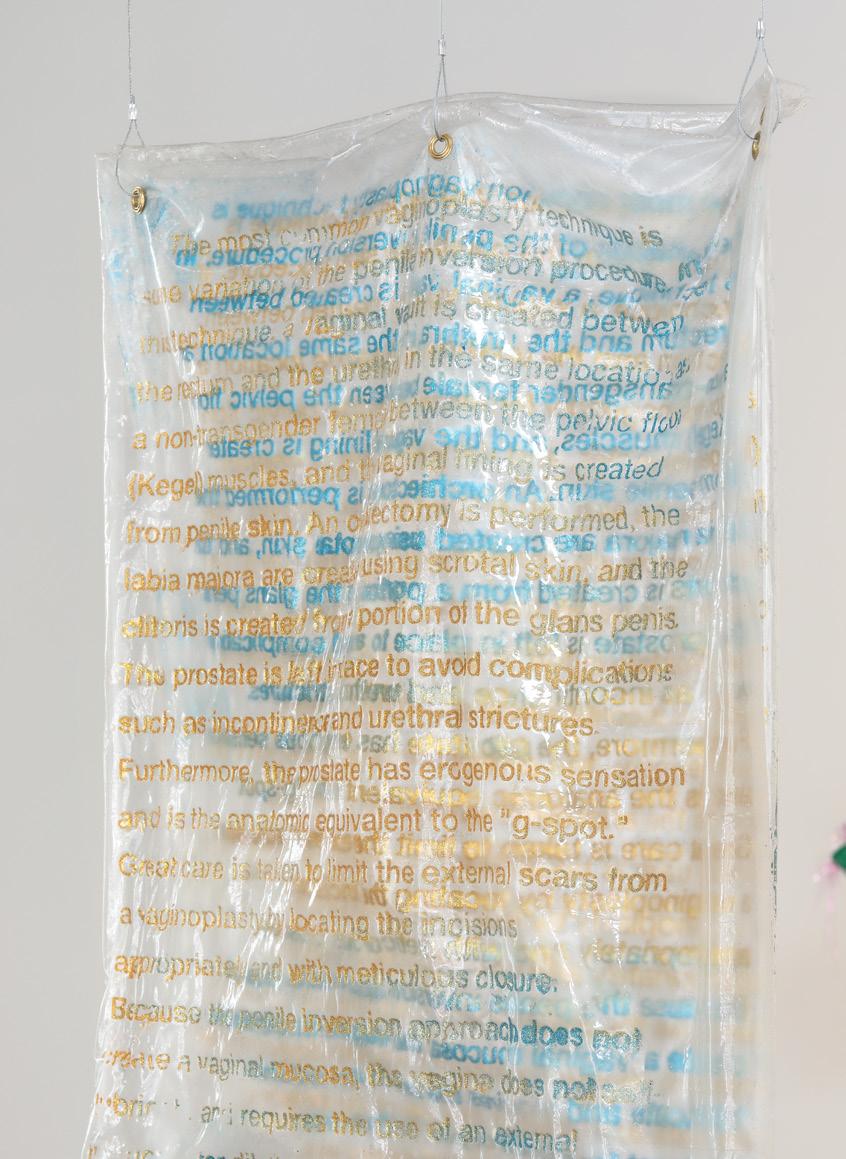
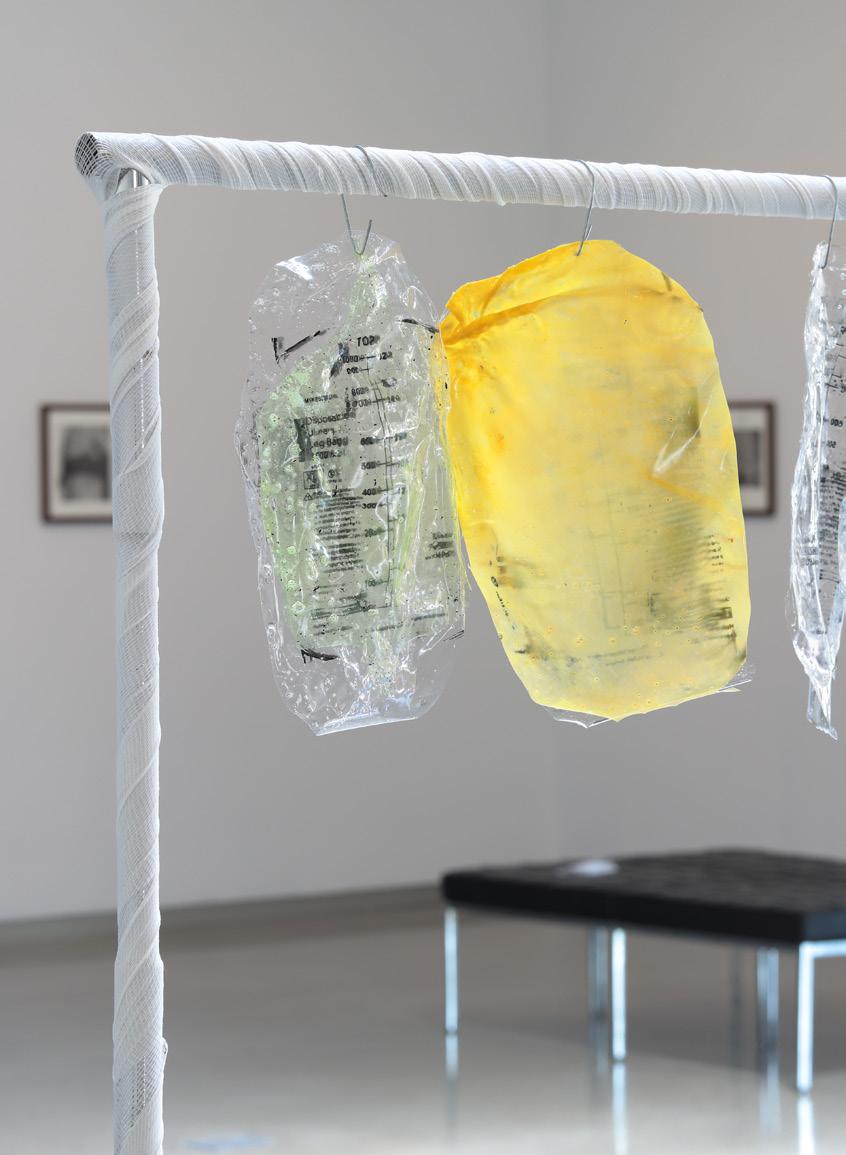
Suzy Slykin
Post Opera is a performance and installation exploring medicalization, labor, desire, belief and transformation. An electric medical bed’s grinding motor is amplifed with contact microphones, while dangling wind chimes inject haunting serenity. Urinary catheter bags are remade using clear plastic glue. The work blurs a hospital recovery room with a stage - probing the ongoing labor of survival under capitalism. Ritualized performance cites medicalized transition as reproductive, social, and embodied work. It asks: Can surgical transformation resist the demands of legibility, instead embracing pain, pleasure, and self-sovereignty as forms of reclamation?
Bags, 9 selected works (p. 74–75)
Post Opera Performance installation (p. 76)
Medical bed, surgical lamp, bandages, gauze, amp, distortion + reverb pedals, wind chimes, contact microphone, acrylic glue, screen printed text, glitter, thread, grommets, display rack
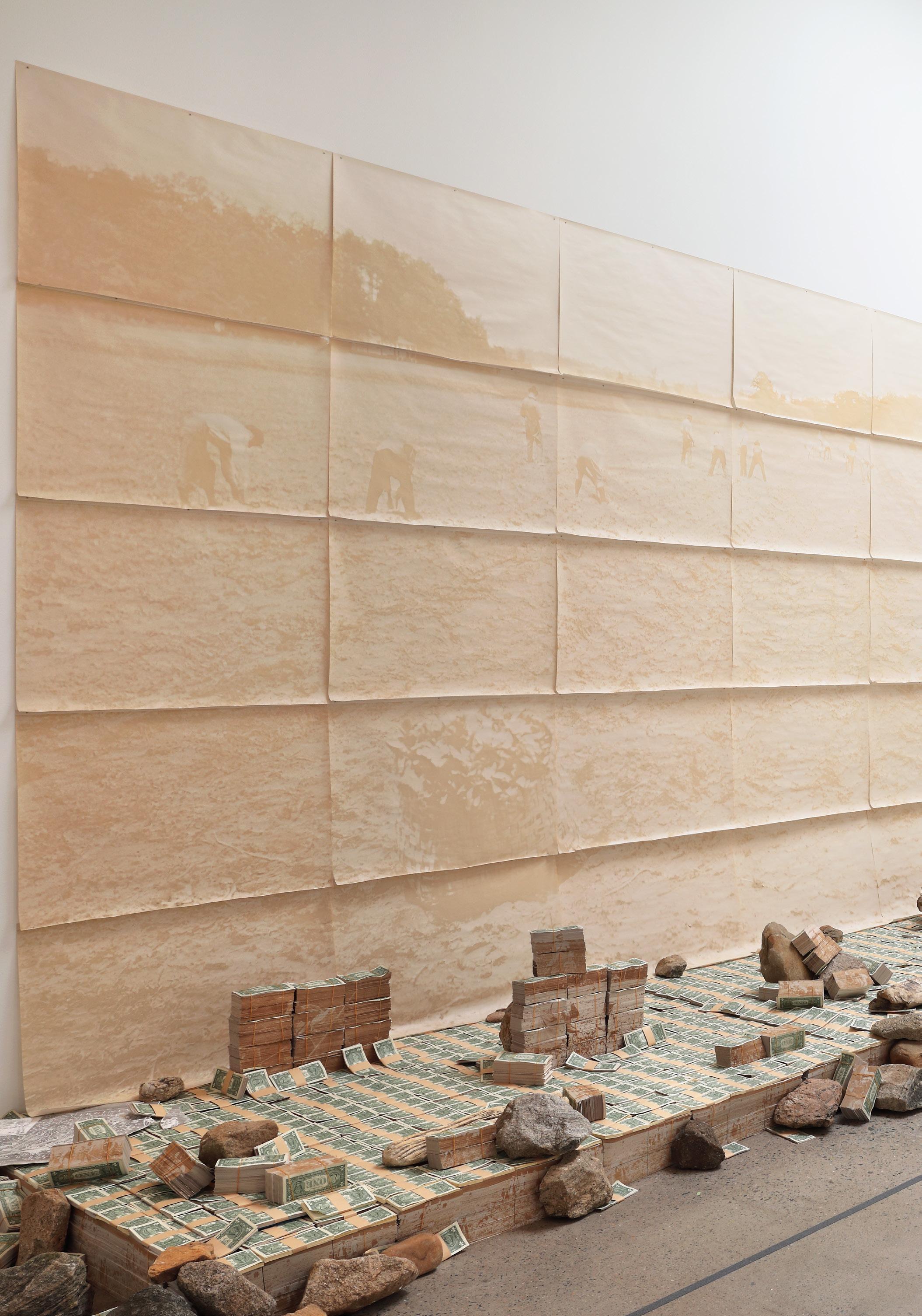
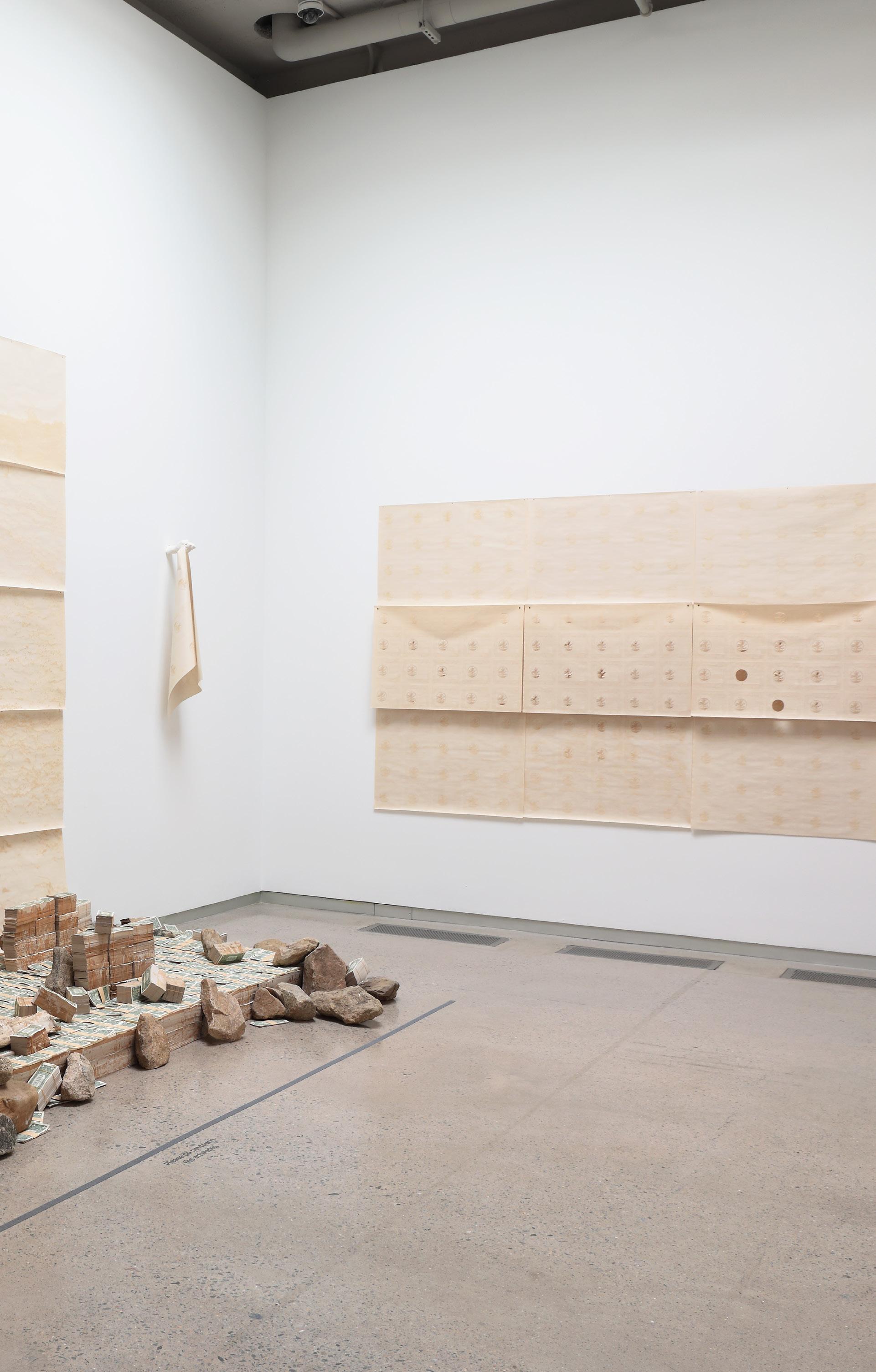
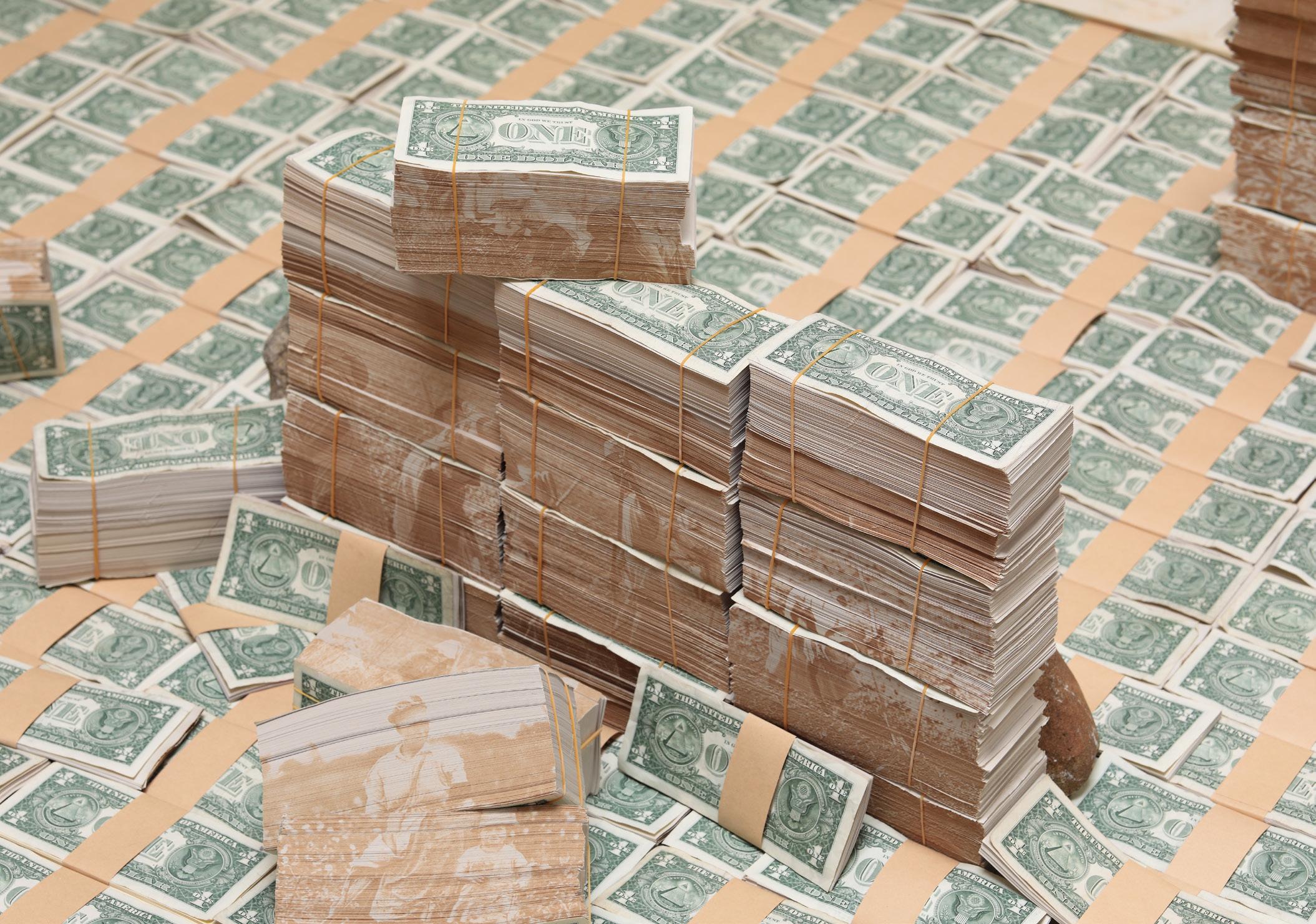
Installation view (p. 78–79)
The paradox of value: on the (in)visibility of labor (Above)
Newsprint paper, U.S. dollar bills, Library of Virginia archive photos
David Guarnizo
I explore the ways in which the fauna, flora, and geography of specific territories, as well as the people who inhabit them, are represented in coins, paper money, banknotes, or commercial documents. I consider these numismatic elements, and any trading artifact, as manifestations of our cultural, social, and political constructions; as evidence of the layers that constitute the history of any community.
Furthermore, my work explores the ways that communities around the world, particularly in the Americas, construct their archetypes of value and wealth. I examine how these archetypes influence the way we contemplate, inhabit, care for, alter, build, or even destroy our environments and landscapes.
The paradox of value: on the layers of history (Opposite)
Newsprint paper, natural fiber paper, plaster
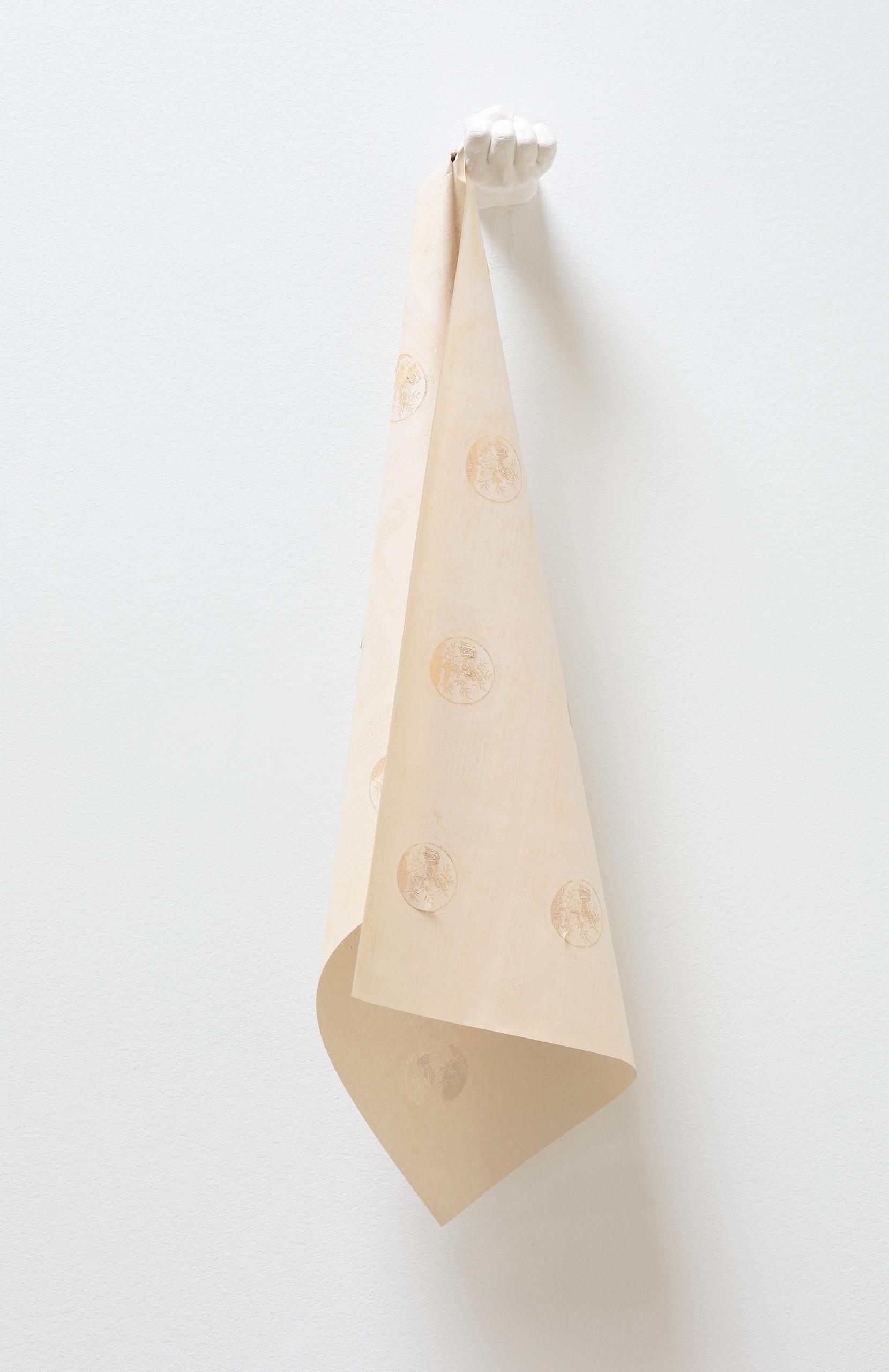


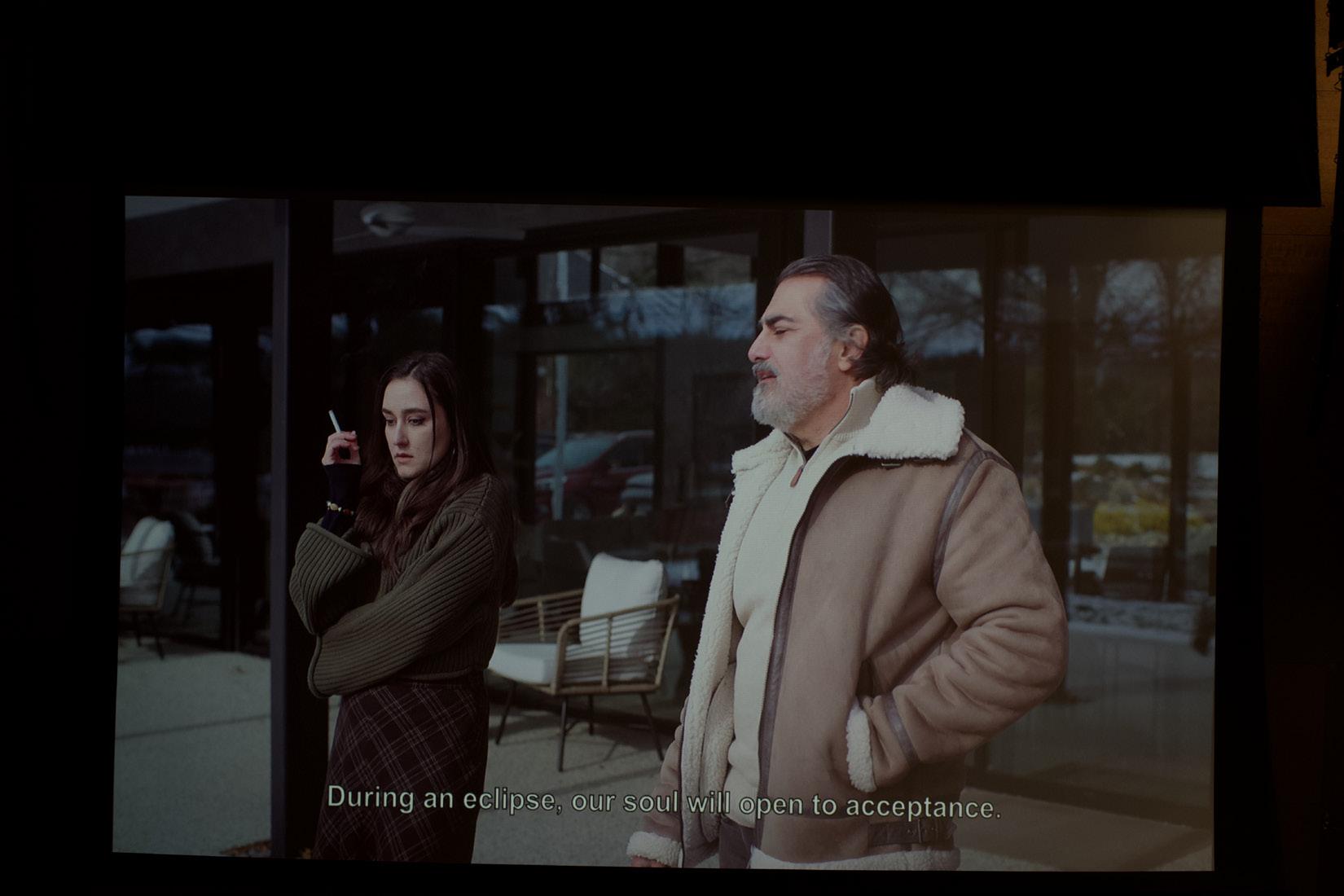

Sina Khani
At a company party, Forough, an Iranian intern, becomes the target of a psychological game orchestrated by her boss. She’s forced to question her place in this unfamiliar space when accusations blur the line between joke and spite.
In this project, I wanted to explore the role of assimilation as a path to belonging within spaces that prove harmful to outsiders. I aimed to depict how wealth and power dynamics shape perceptions, control narratives, and manipulate reality.



Lars Mattingly
Platinum-palladium prints last for 1,000 years. I transform fragments of time and pieces of people I love into precious objects. Without beauty, the pain of remembering past traumas becomes too much. Perhaps these photographs are a reminder that joy and ache coexist; we must keep going. with us on this journey.



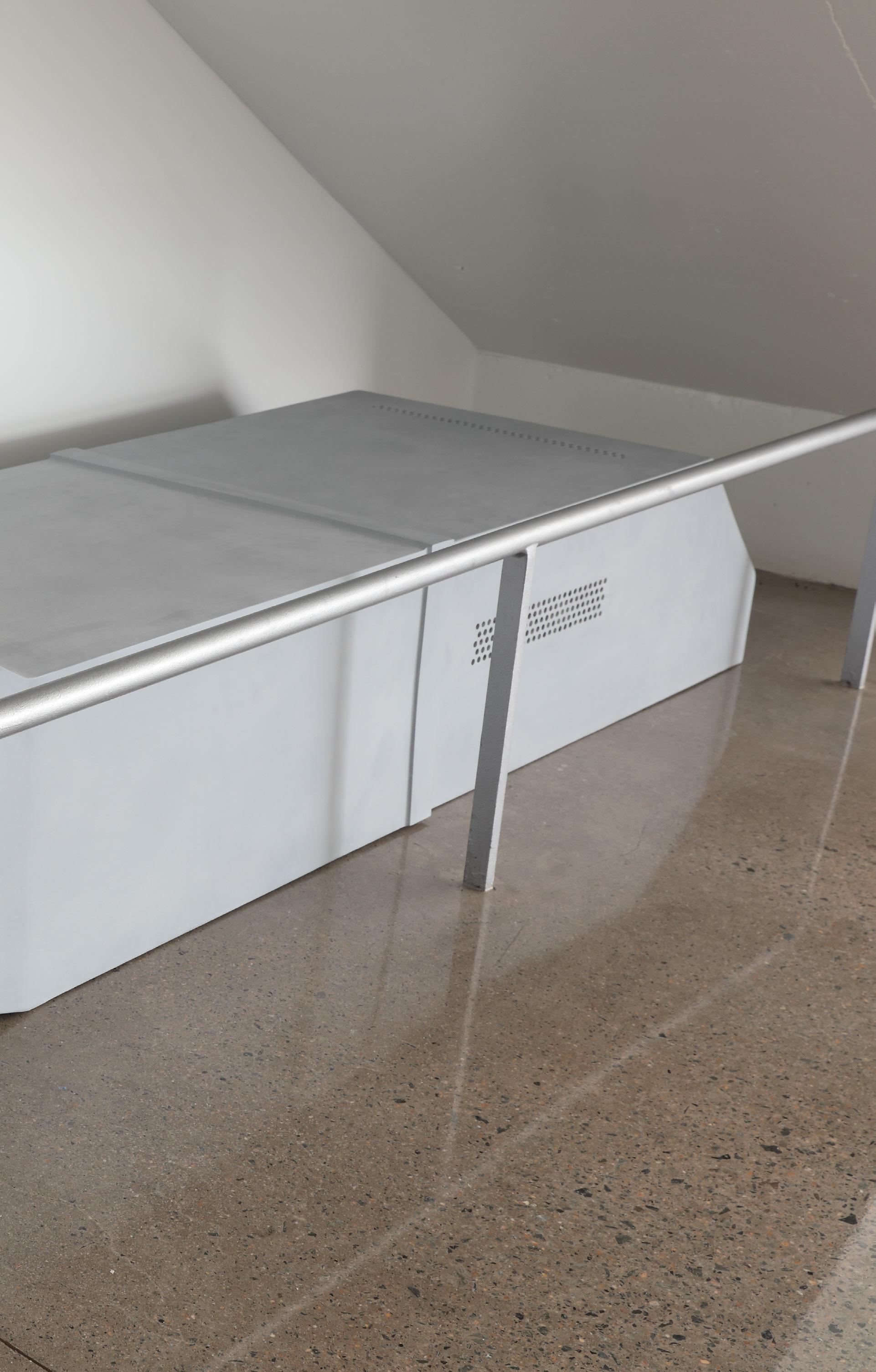
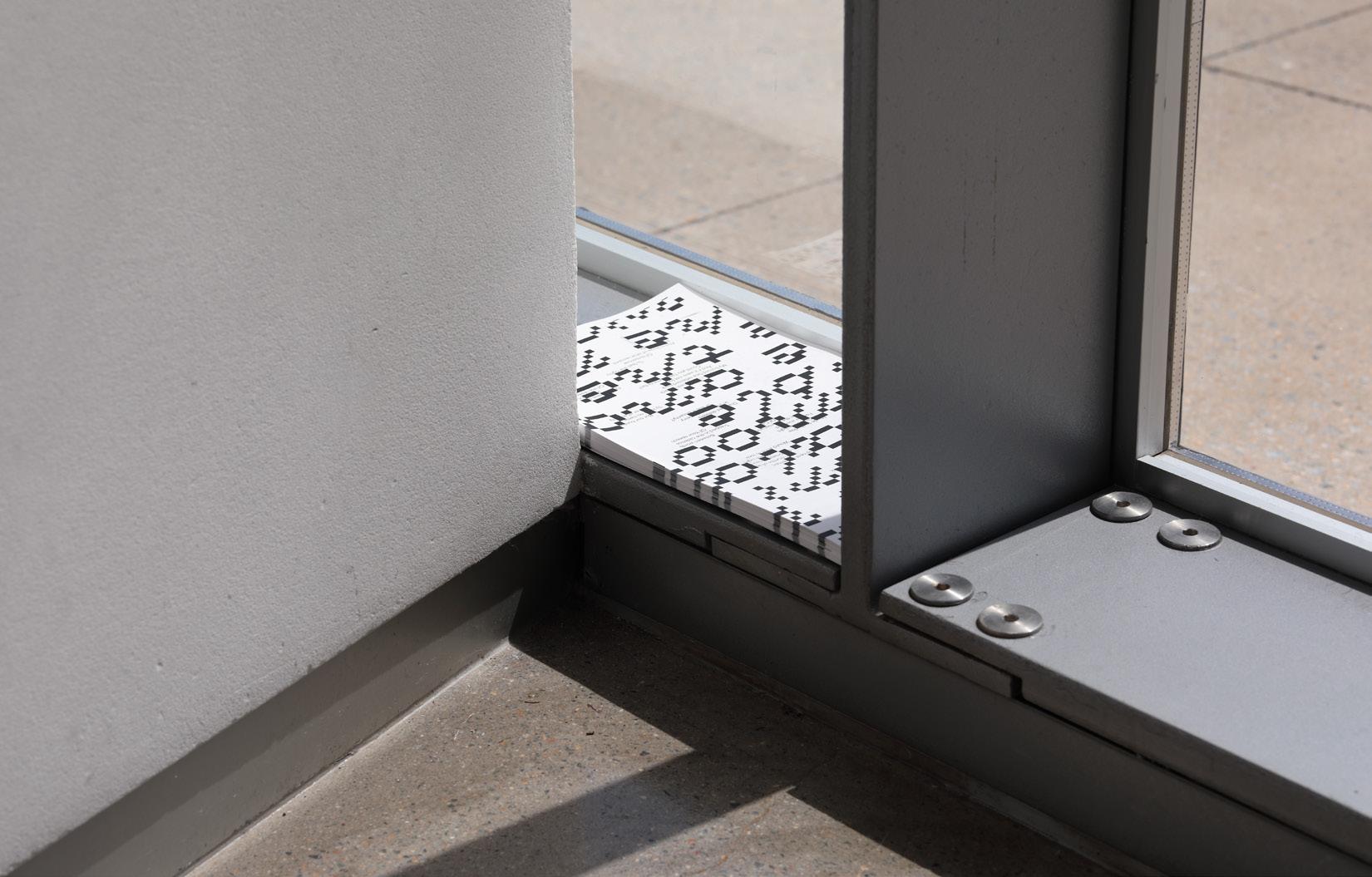
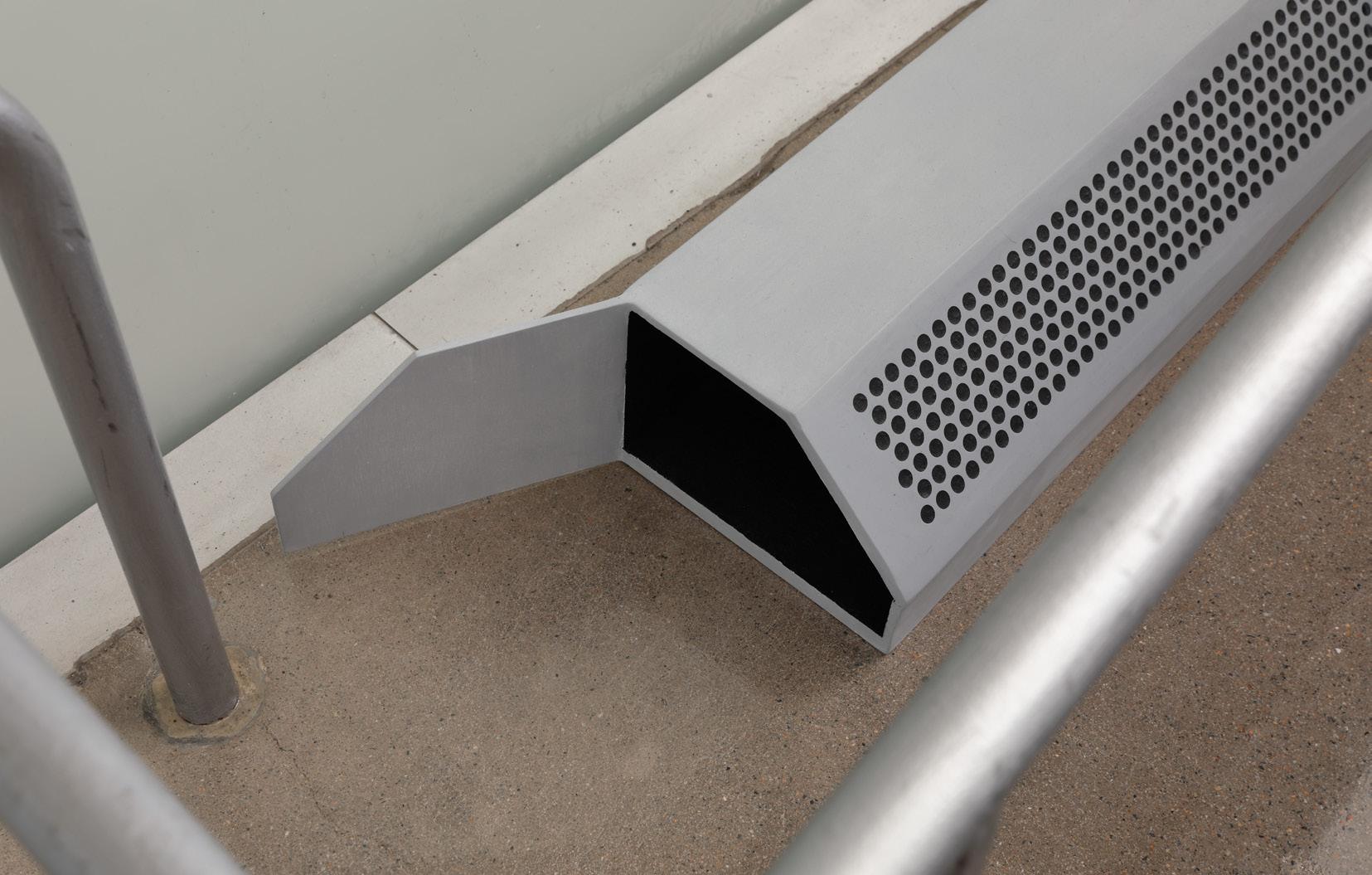
UNNAMED
(p. 90-91)
Wood found in VCU construction dumpsters, plywood, MDF, wall studs, wood glue, drywall tape, found metal shelves, joint compound, primer, insulation foam, tar, projector, video (color, sound, 3 min., 56 sec. loop), media player, found thread, steel, reading lights, cabinet lights, desk fan, metal framing found in VCU construction dumpster, enamel, weather stripping, electrical tape, power adapters, remote control outlet, surge protector, extension cord, conduit pipe found in VCU construction dumpsters, conduit fittings, conduit body, outlet covers, power extracted from the building, water extracted from the air, touch, dust
UNNAMED
(Opposite, top)
legal size inkjet print, variable edition
UNNAMED
(Opposite, bottom)
wood found in VCU construction dumpsters, plywood, MDF, wall studs, wood glue, drywall tape, found metal shelves, hinges, joint compound, primer, liquid latex, enamel, water extracted from the air, wireless speaker, media player, touch, dust, digitally manipulated audio recording of the ICA’s exterior HVAC vents
58 min., 34 sec. loop
h.r.g.
I like to think of all bodies as being porous in one way or another. From the objects we encounter to the buildings we inhabit to our own bodies, everything exists within a system that, try as we might, remains open.
Through language, unseen performance, sound, light, video, architectural intervention, and objects situated throughout the ICA, IN THE WAKE OF THE DESIRING PATH engages the institution not as a hermetic, closed, body, but as one susceptible to change and infuence via the various bodies that move through it.
By recalibrating the way we look at and experience artwork, my practice aims to impact how we encounter one another, recognizing that these systems of relation refect broader systems of power and oppression in our culture at large.

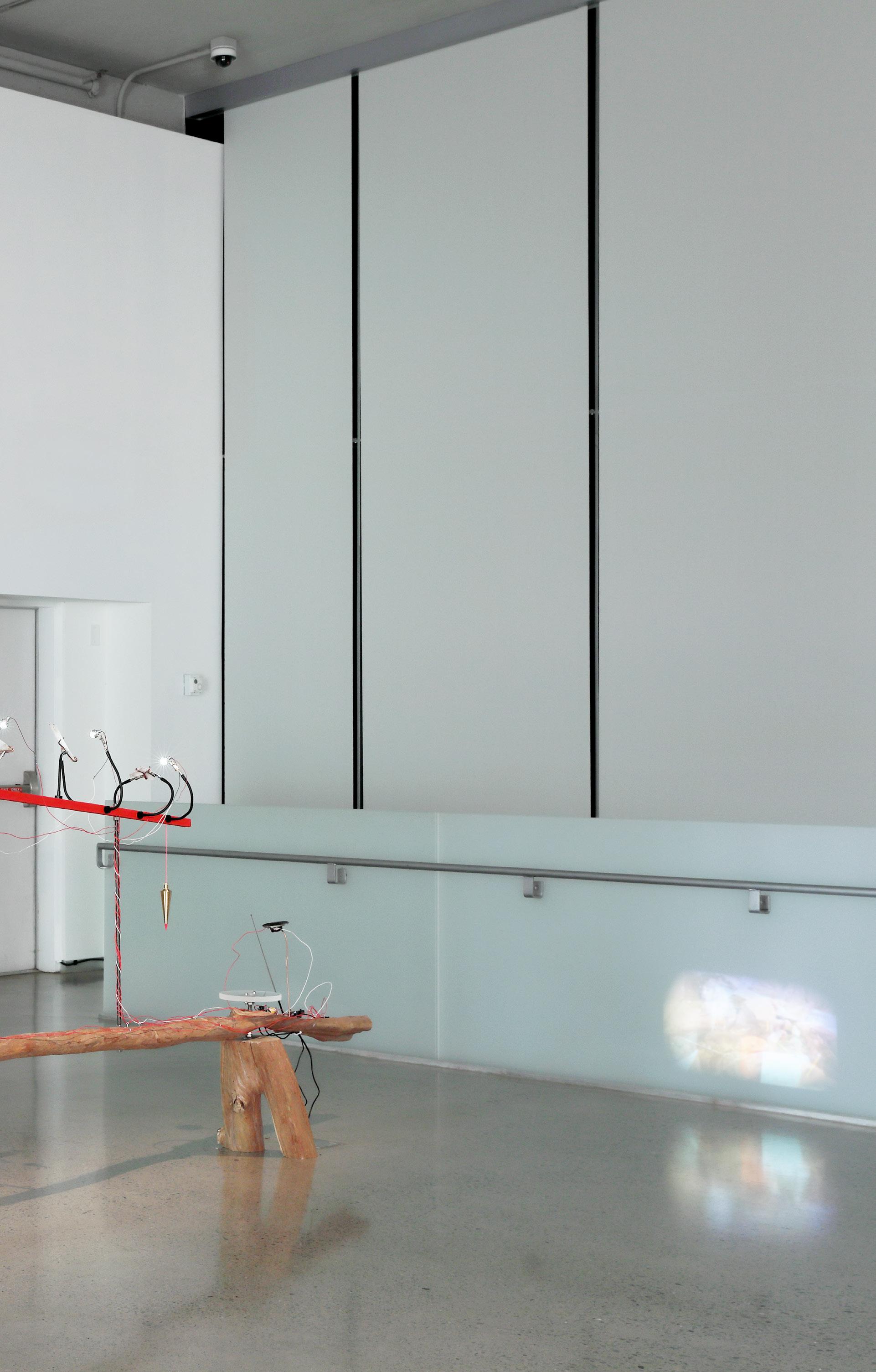

August Neuscheler
Participating in a variety of cultural and archaeological processes, I attempt to supercollide then reassemble the past and present around a single object-event. A ceramic fute is designed and manufactured, used, buried and laid in repose, and is excavated to be turned into data for display. Glimpses of this of-site series of performances are seen in two works, an enlarged sherd hanging from within the skylight in the main gallery, and a construct for viewing the sherd in the darkened secondary gallery. I’d like to speak to the fraught relationship between history, the tools of perception, and materiality.
Installation view (p. 94–95)
Apparatus (Detail)
Crepe Myrtle, steel, hardware, paint, Plexiglas, magnetic alligator clips, plumb bob, deconstructed radio, wiring, LEDs, microcontroller, bare copper, construction line, bone die, low-fire ceramic, dirt
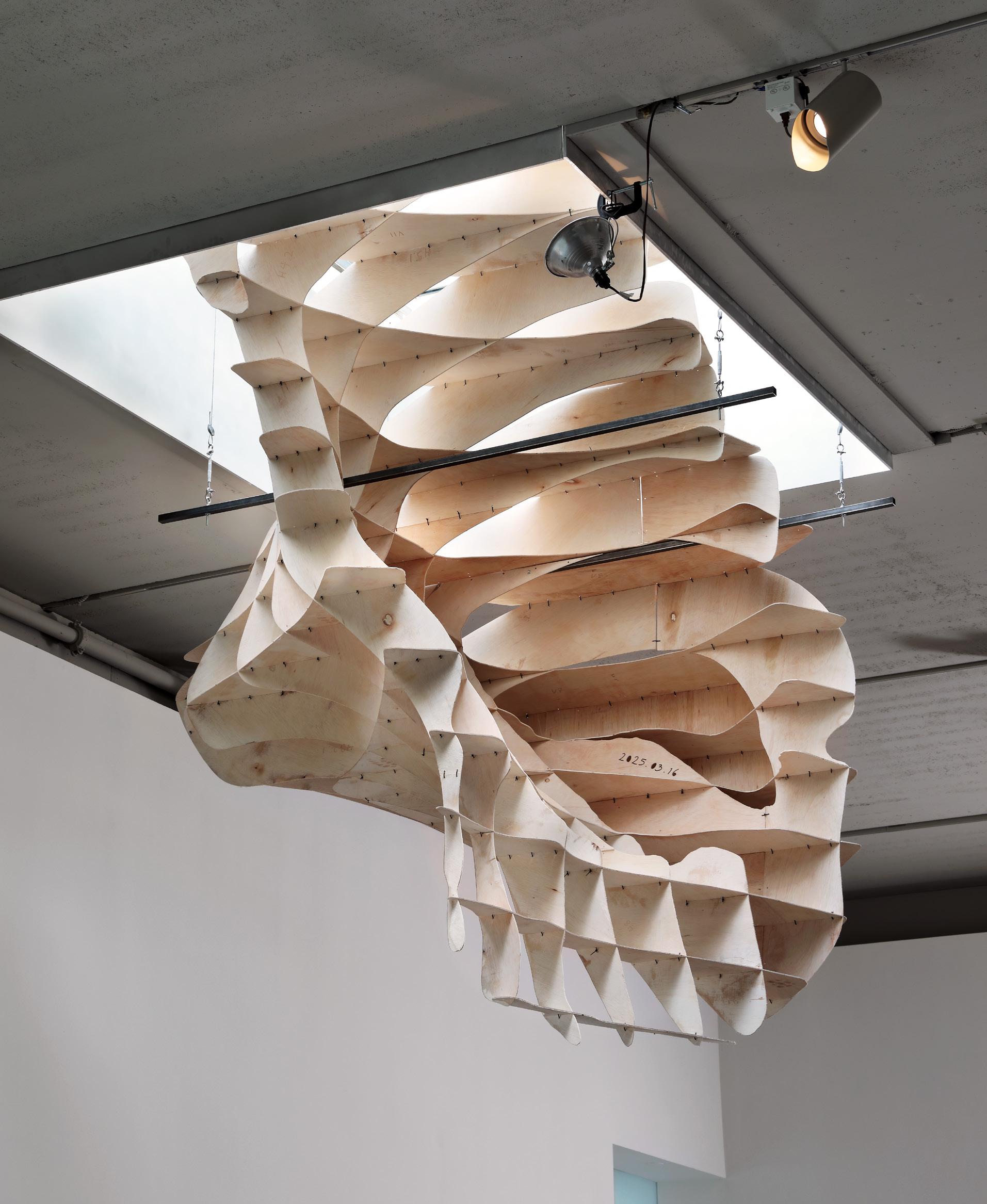
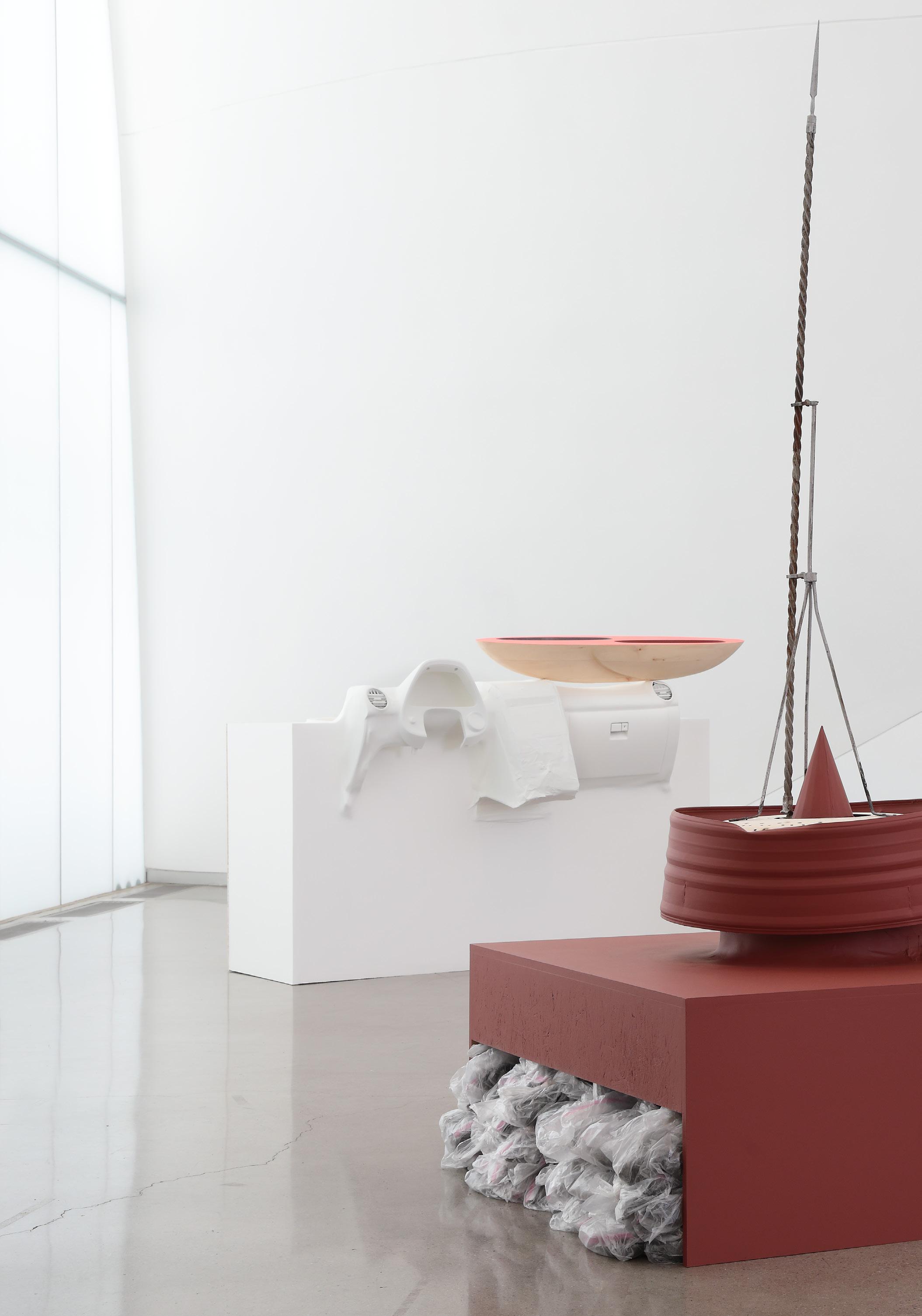

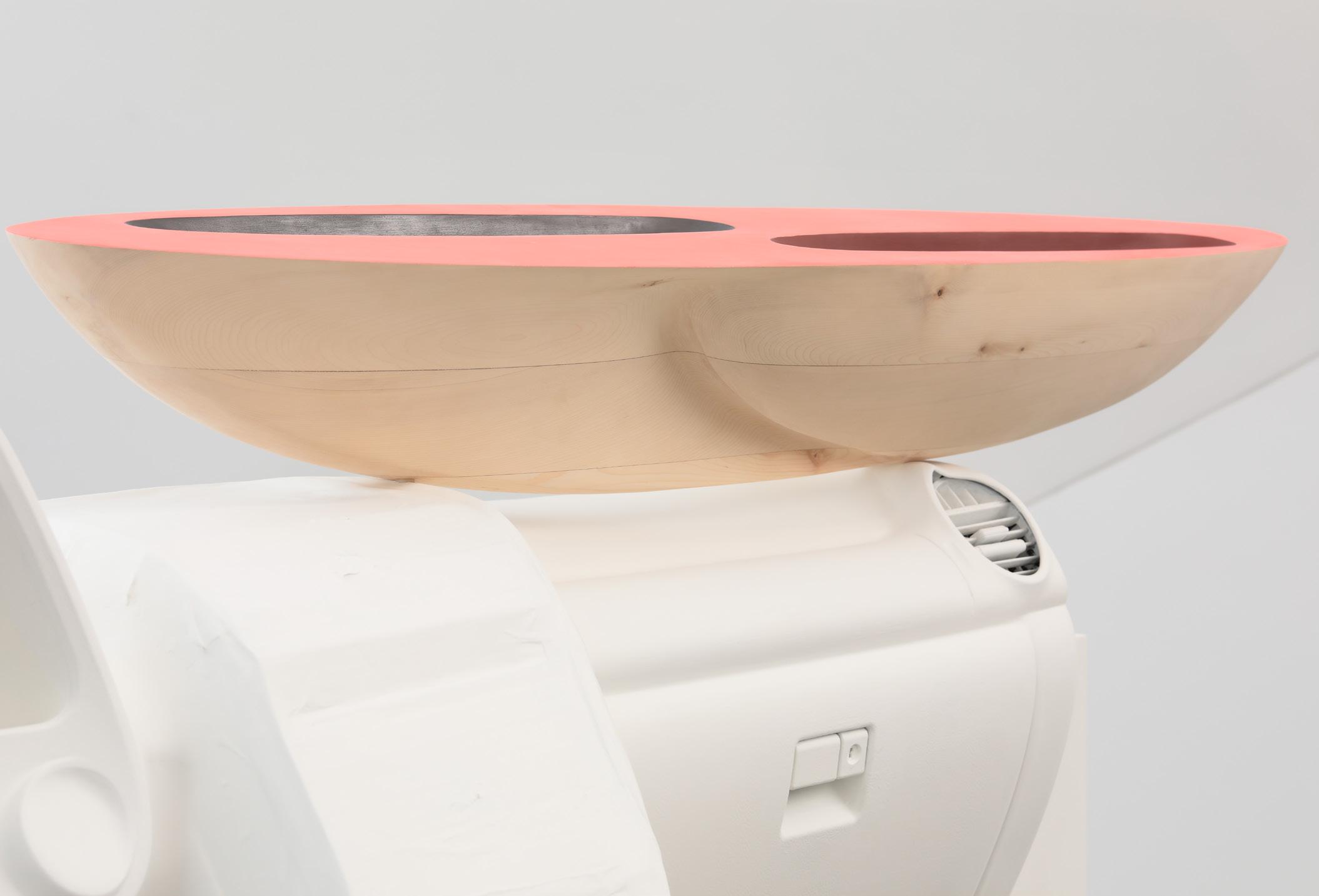
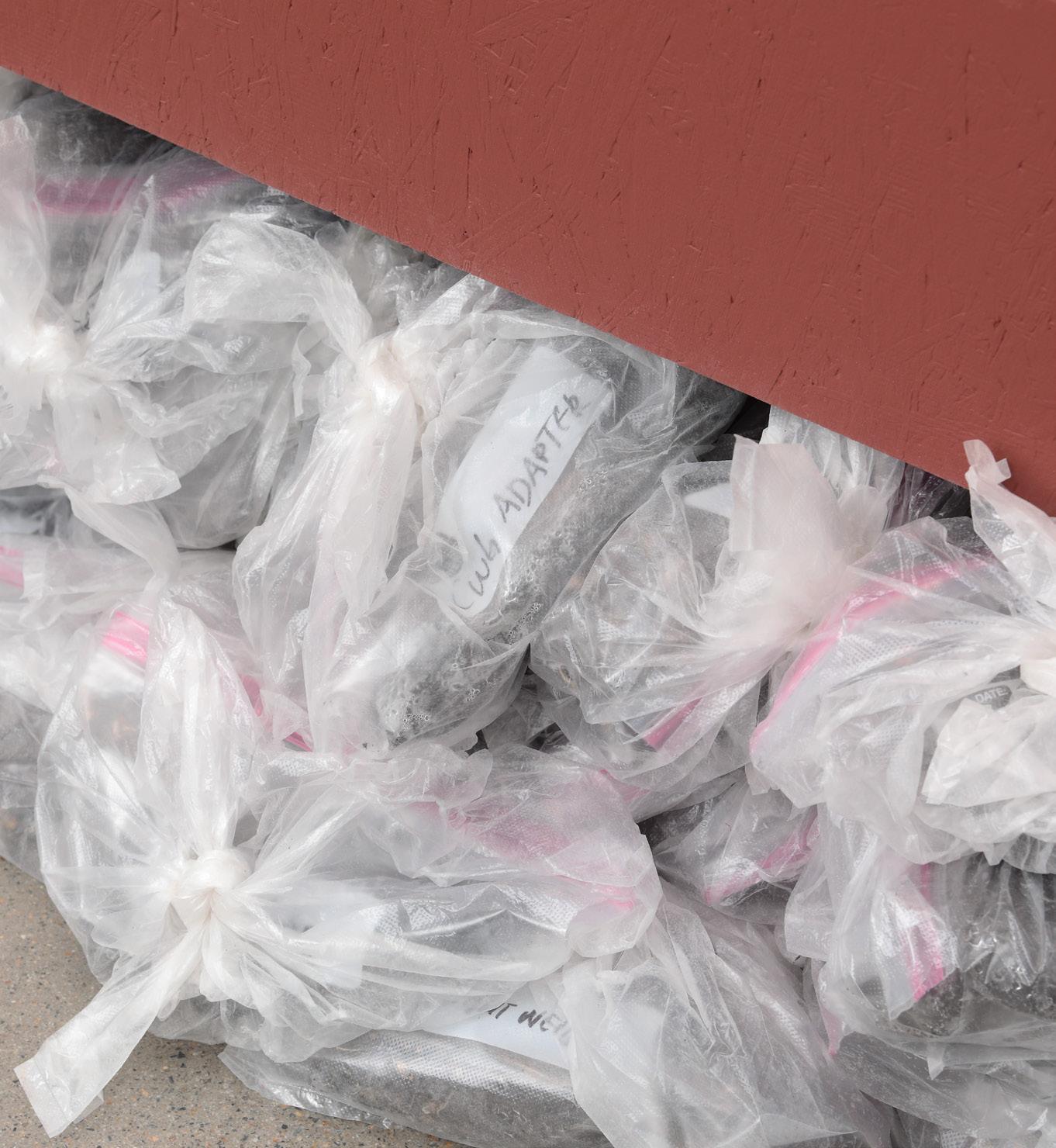
Installation view (p. 98–99)
sieve
Detail view (Top)
carved yellow cedar, MDF, glue, screws, joint compound, wire mesh, patch tape, duct tape, latex paint, 65gal rainwater collection barrel, 55gal trailer antifreeze storage container, 5gal paint buckets, 5gal water container, etc.
channel
Detail view (Left)
carved yellow cedar, MDF, OSB, glue, screws, joint compound, wire mesh, patch tape, duct tape, latex paint, barn cupola, lightning rod, ziploc bags, plastic bags, mulch
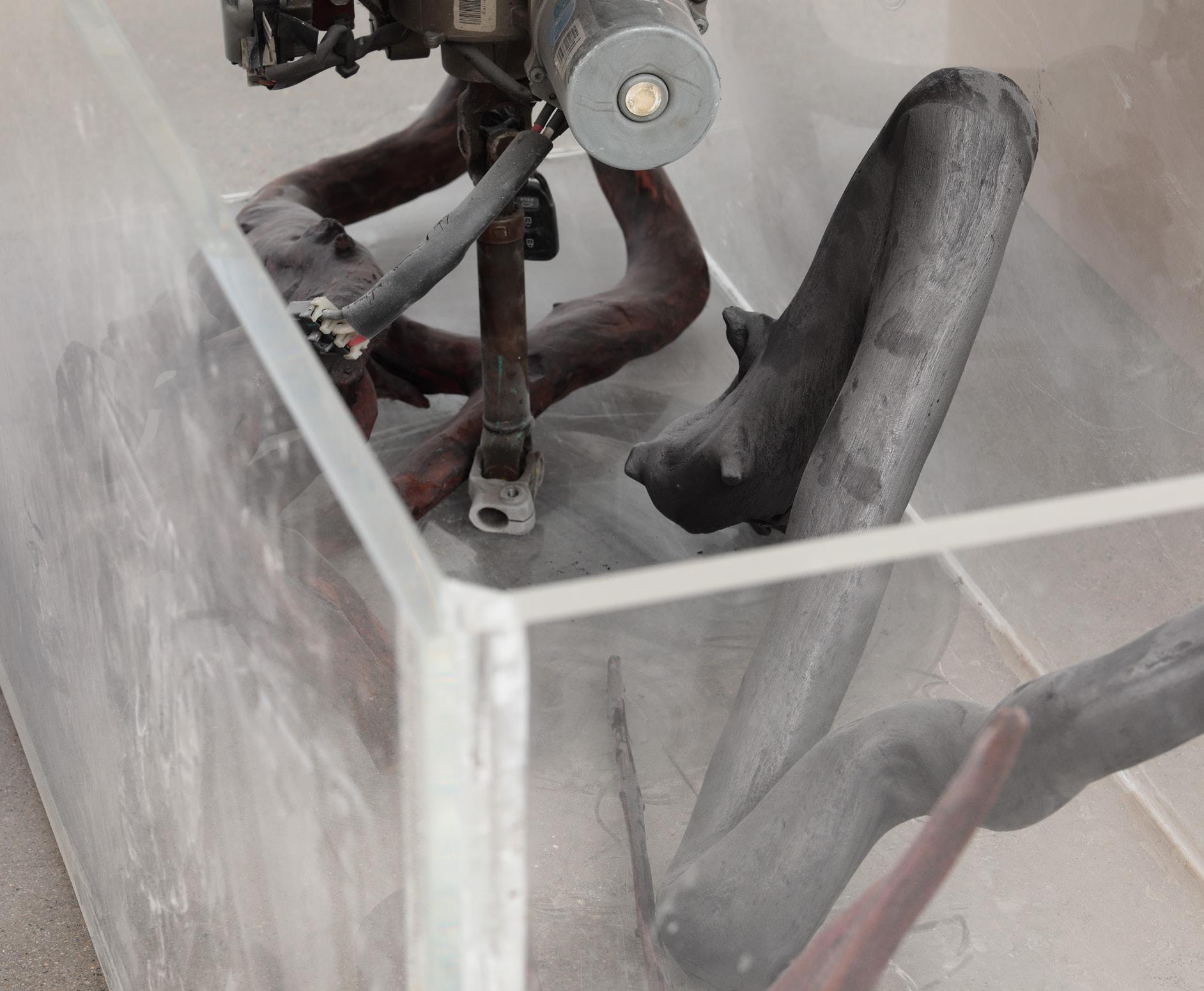
Tyna Ontko
mutual realm is a container for my thoughts on speculative futures, present-day-truth-telling, and the everyday construction of histories. Informed by systems of belief and power that humans have created to grapple with the unknown, it illustrates how storytelling builds worlds, assigning value to things by inscribing them with desire. In parts fact and fantasy, sculpture is considered as a form of sorting, highlighting my own experience of living between publics whose methods for demarcating boundaries, communally agreed upon superstitions, and algorithms for assigning meaning have marked my unconscious and afect my everyday trajectories. Here, space exists in myriad forms—as a blueprint, a tool, a dream, or a lived experience.
celt
Detail view
Carved yellow cedar, MDF, OSB, glue, screws, joint compound, wire mesh, patch tape, duct tape, latex paint, cardboard, 150gal reptile tank, vehicular dashboard, steering column, sink bowl, cedar driftwood, graphite powder, argan oil, Valvoline red grease
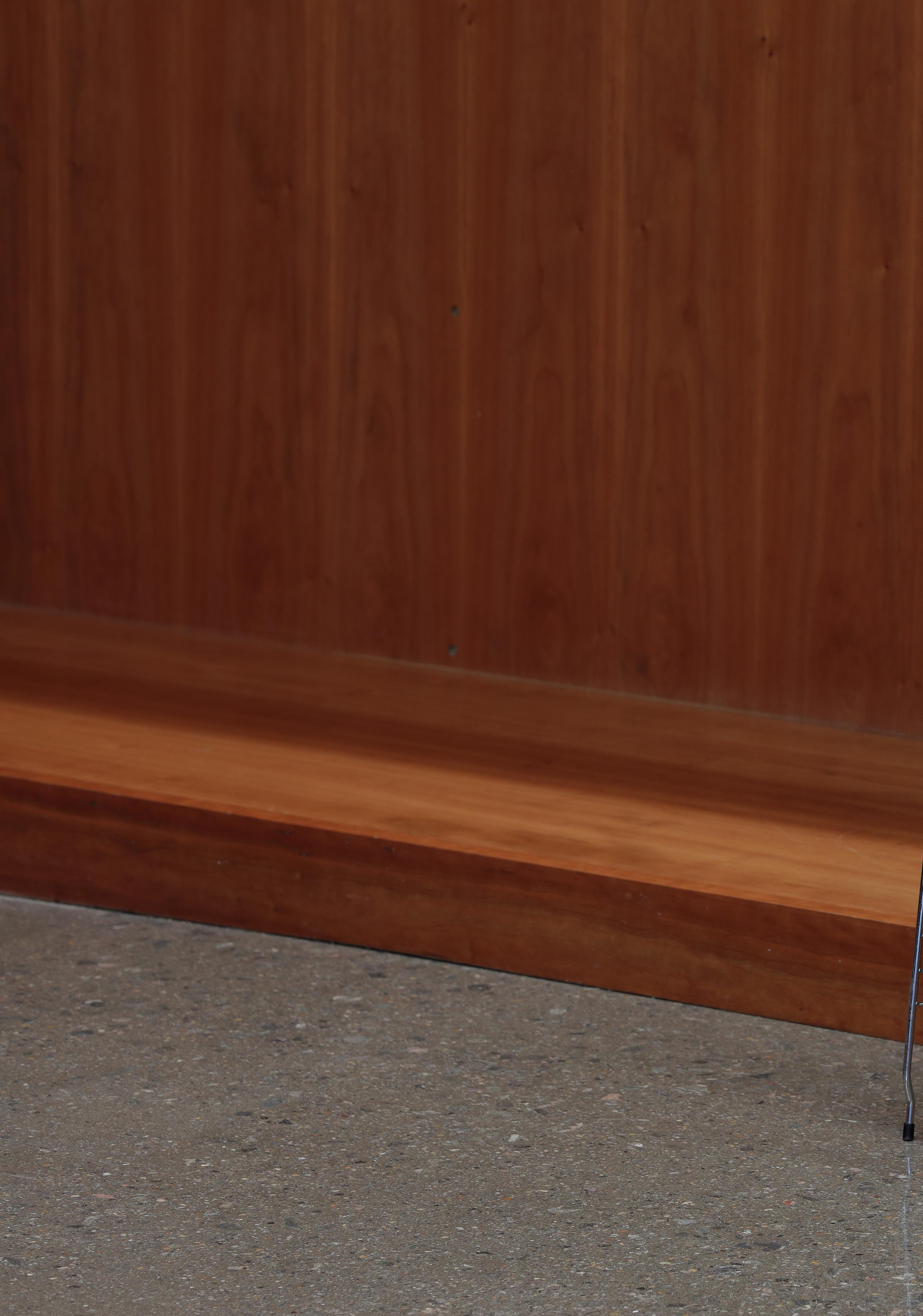


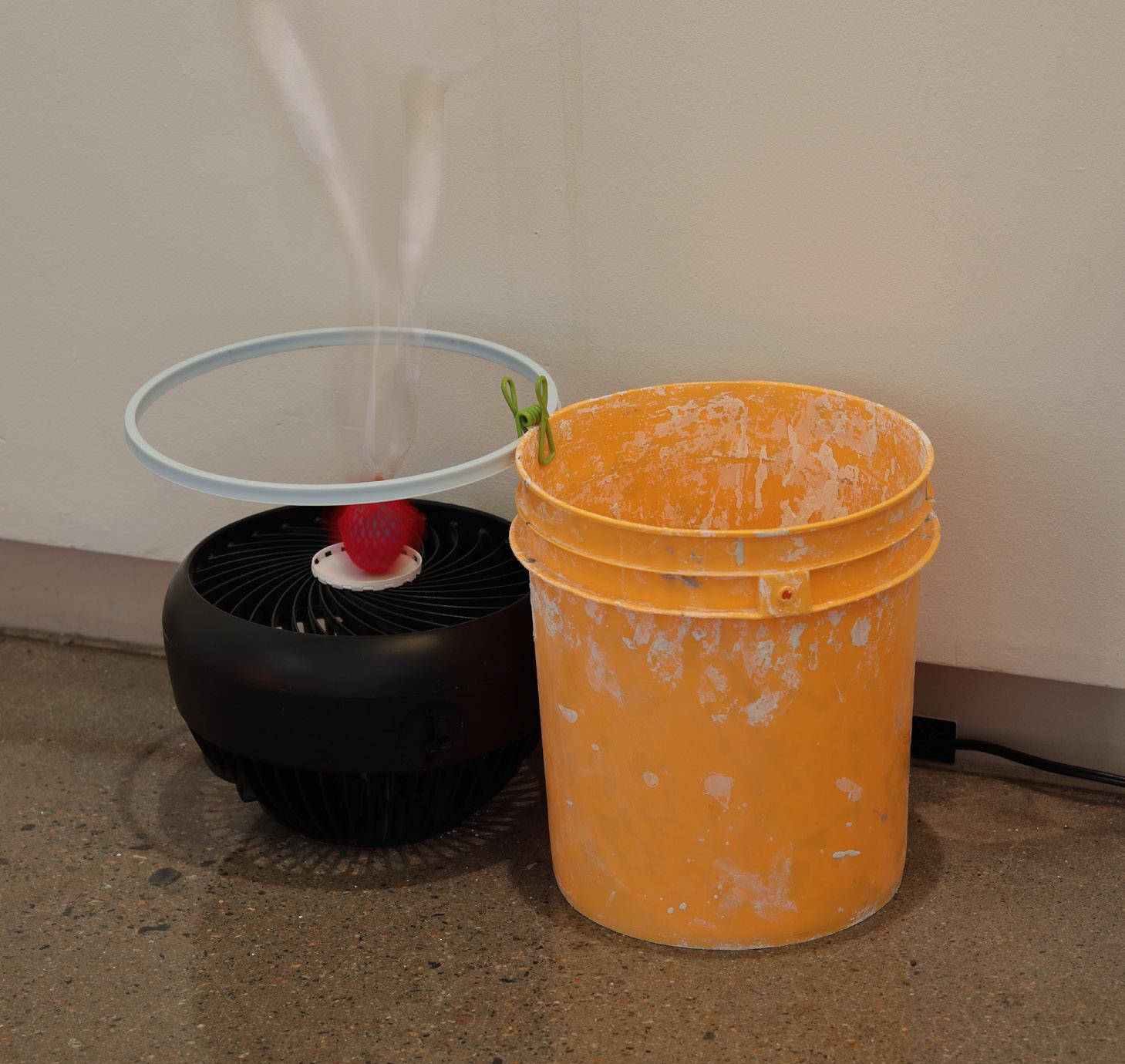
Desktop (p. 102-103)
Wood, glass, sand, epoxy, found and collected objects (metal shelf, manila envelope, metal rack, metal shelf bracket, metal hook, light pull, plastic cap, bracelet, magnet), dryer hose, hair dryer, extension cord, timer
Drawing machine (Above)
Found and collected objects (screw hook, Wiffle Ball, metal rod, bead, tongs, rubber band, golf pencil), mobile motor, dowel
Virginia is for lovers (Left)
Found and collected objects (fan, plastic cap, plastic ball, plastic egg, knit produce cover, ribbon, embroidery hoop, snack clip, bucket), timer
Hannah Rotwein
I am interested in the relationships that emerge between groupings of objects, and how objects can complement, challenge, and extend one another when freed from their prescribed uses. Here, I treat found objects, altered objects, purchased objects, sound, heat, light, and the basement architecture as materials that exist on equal footing. In recasting the basement as a ground for sculptures and treating the sculptures as dynamic and expansive entities, I aim to interrogate hierarchies of value by exploring interrelation that is adaptable, mutable, and interdependent.

Constant freshness
Found and collected objects (laundry hamper stand, laminate from side table, plastic vents, ping pong ball, plastic spoon, holiday lightbulb, laminate from dresser drawer, fan, metal grate, clamp, ring, carabiner), batterypowered LED, dog toy, rubber band
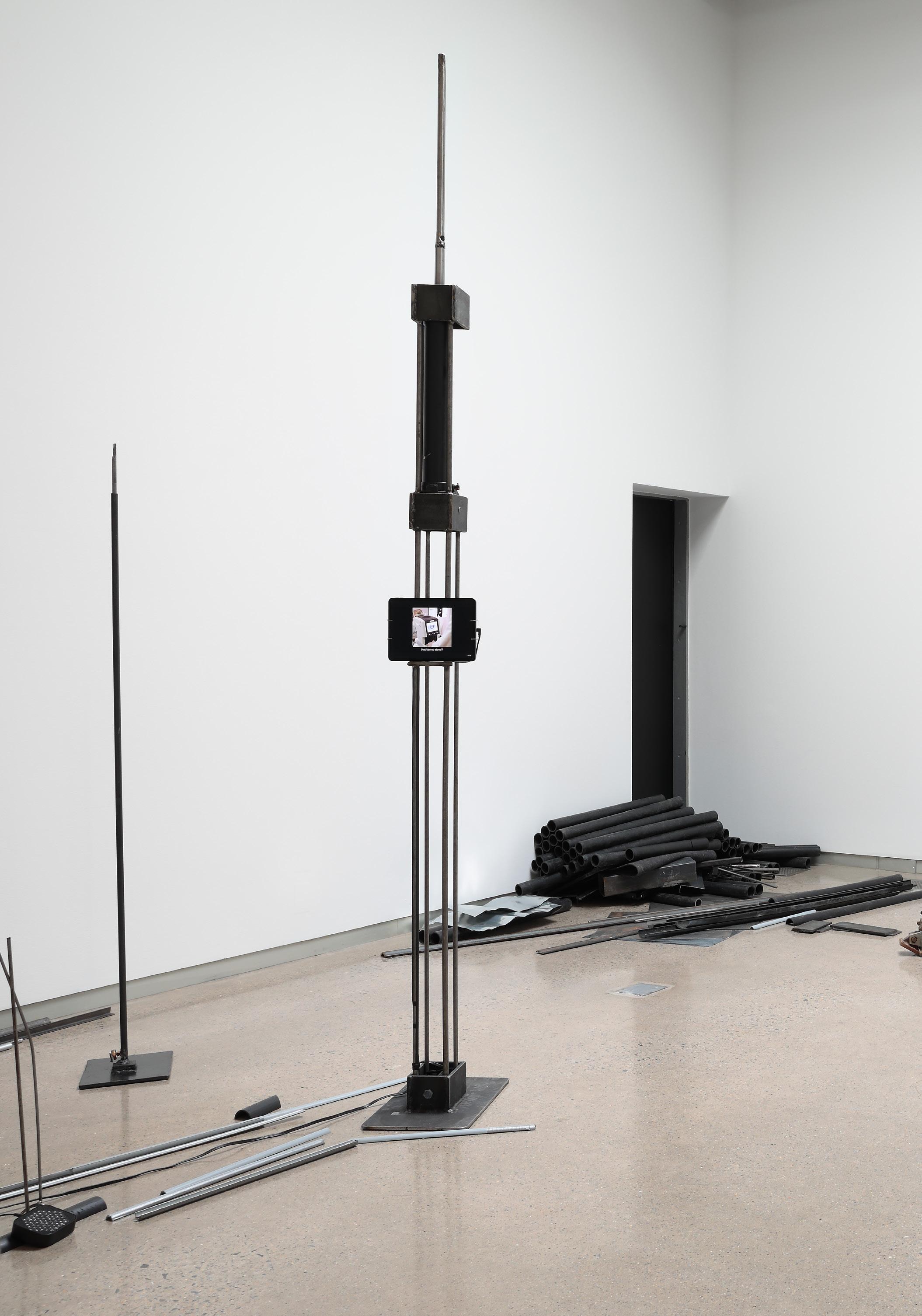
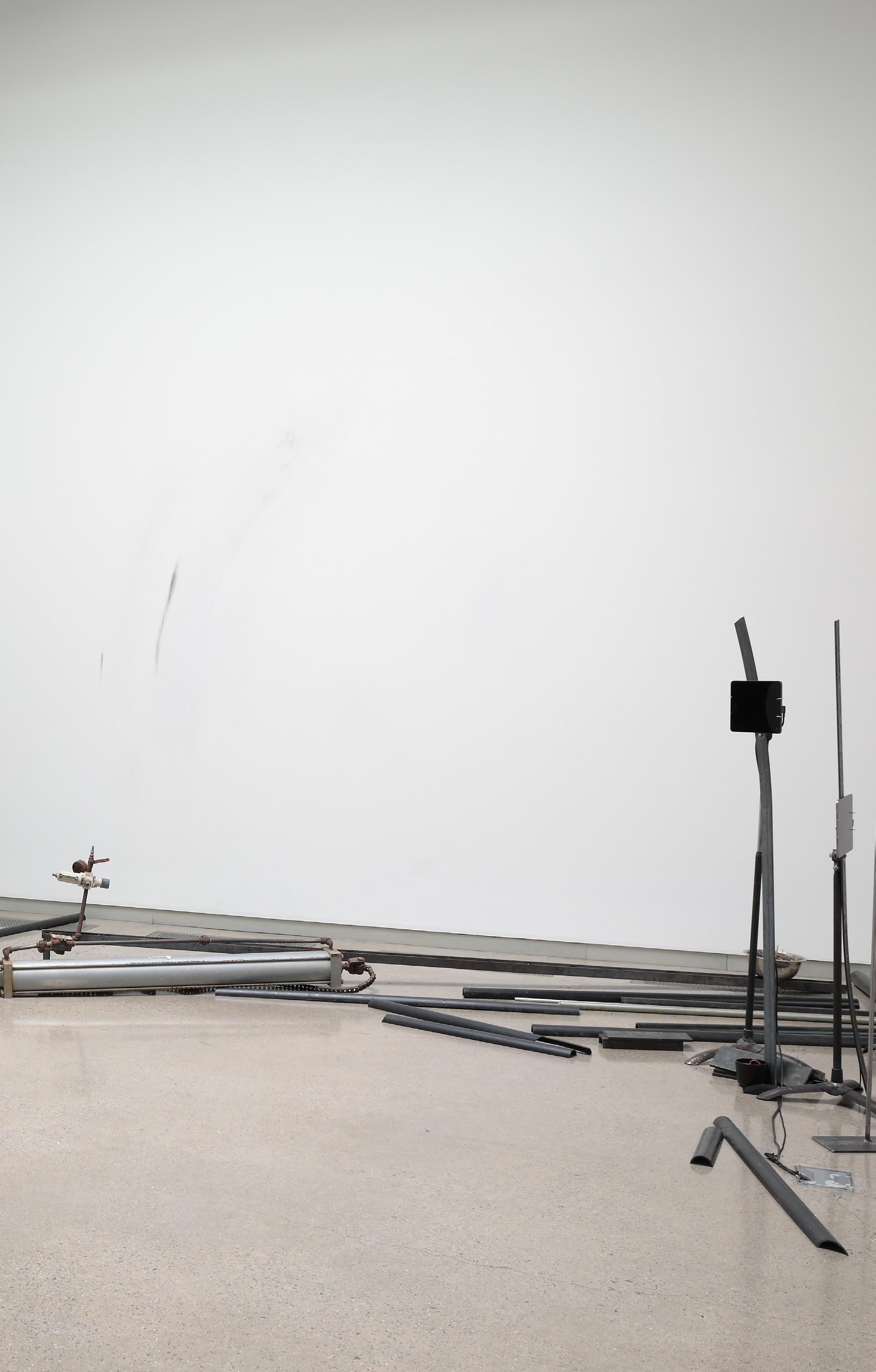
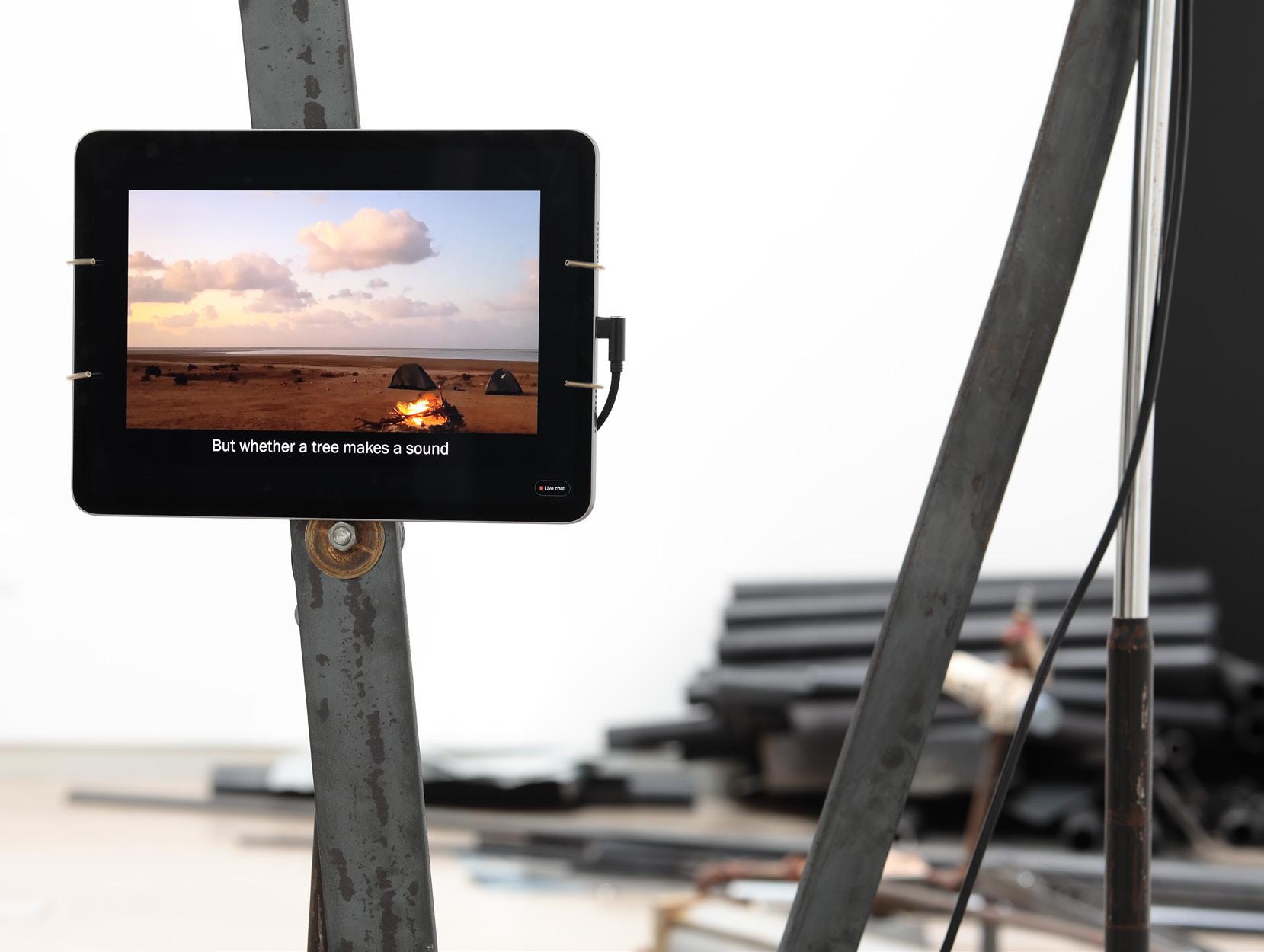
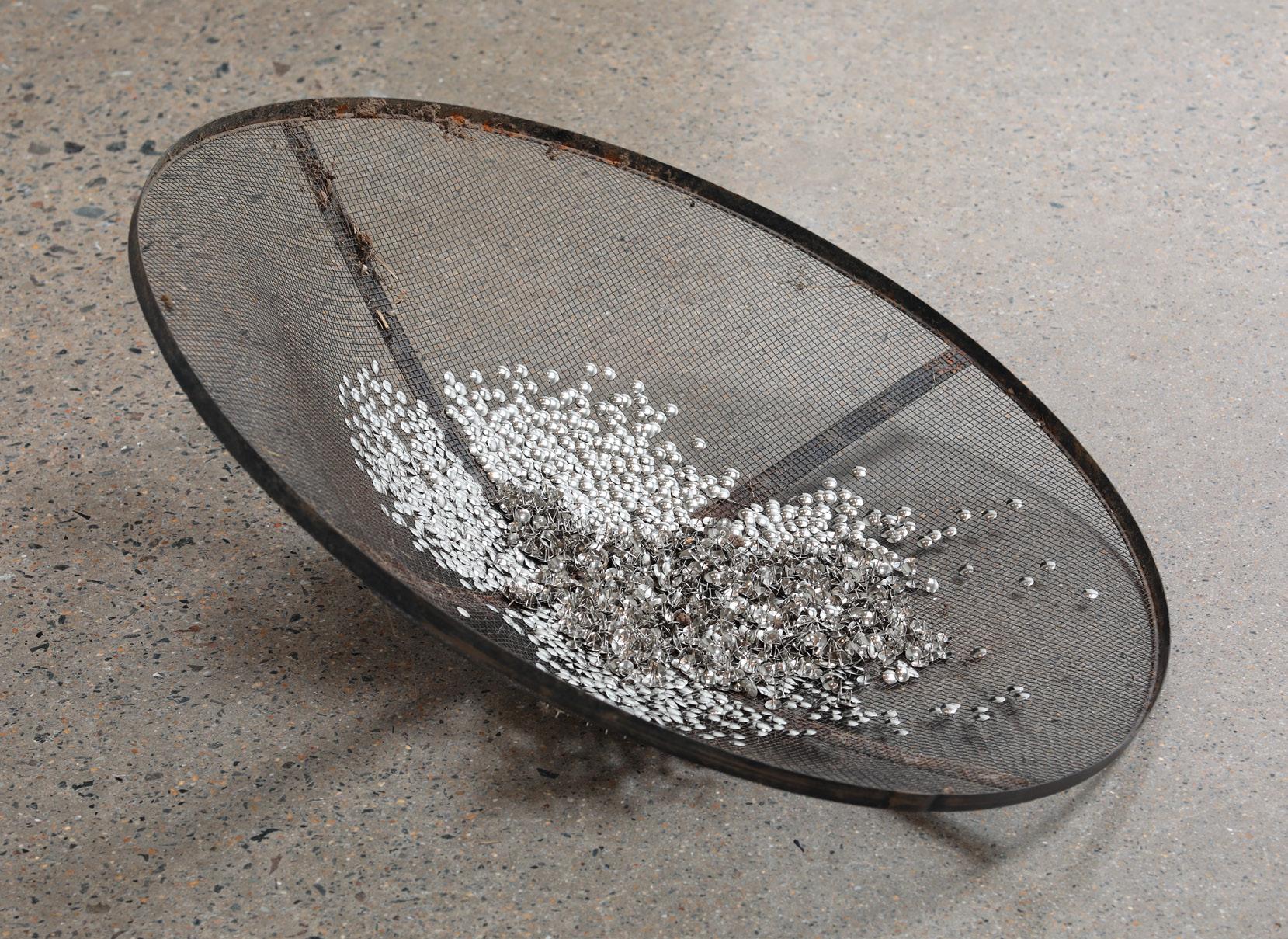

Scientists sent a fnal love song to an unresponsive Mars rover.
Hearing this oriented me towards people and their adoration for objects, and my own fascination for wolf intervals: dissonance when sound waves between two notes fall out of sync. A howl of grit and longing. This discord is required to make precise harmonies in some tuning systems. To avoid hearing it, modern pianos spread the slipped distance of the wolf interval across the keyboard, sacrifcing exact harmonies.
The work builds from this malleable but material ground of sound relationships, defending it from being fxed into false constructions and instead riding the urgency and faith of an unresolved story.
Installation view (p. 106–107)
Growth to beginning of gill formation.
Video story cycle (11 minute loop), TikTok audio filter “Gigi,” scrap steel, found objects, ash. Dimensions variable.
Cover Image
Rasim Bayramov
Anya Kobayashi
Photography
David Hale
Keshia Eugene (p. 38-41)
Video stills courtesy of the artist (p. 42-45) and (p. 82-85)
Design
Shanice Aga
Virginia Commonwealth University School of the Arts
Pollak Building, Suite 201
325 North Harrison Street
Richmond, VA 23284-2519
